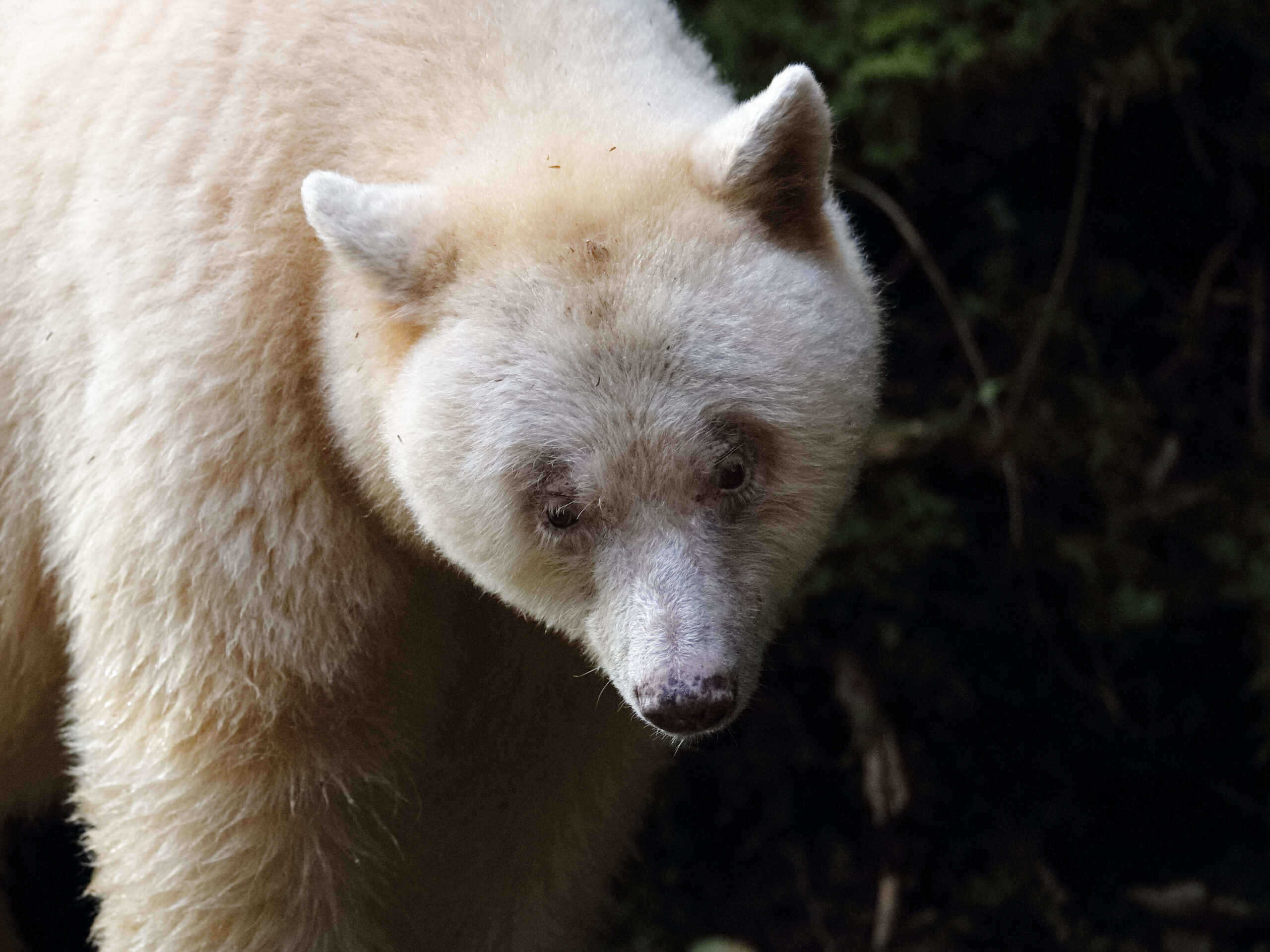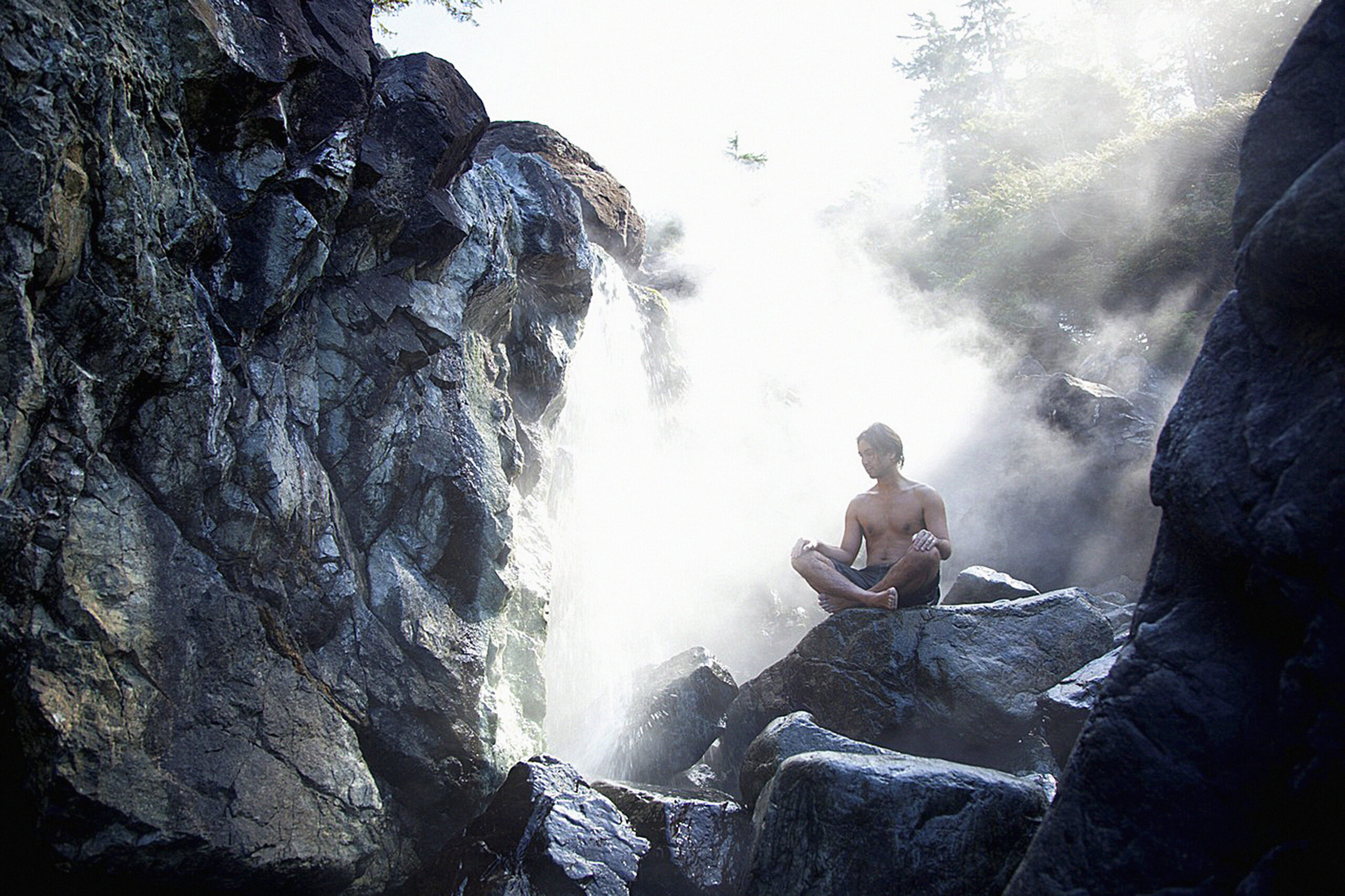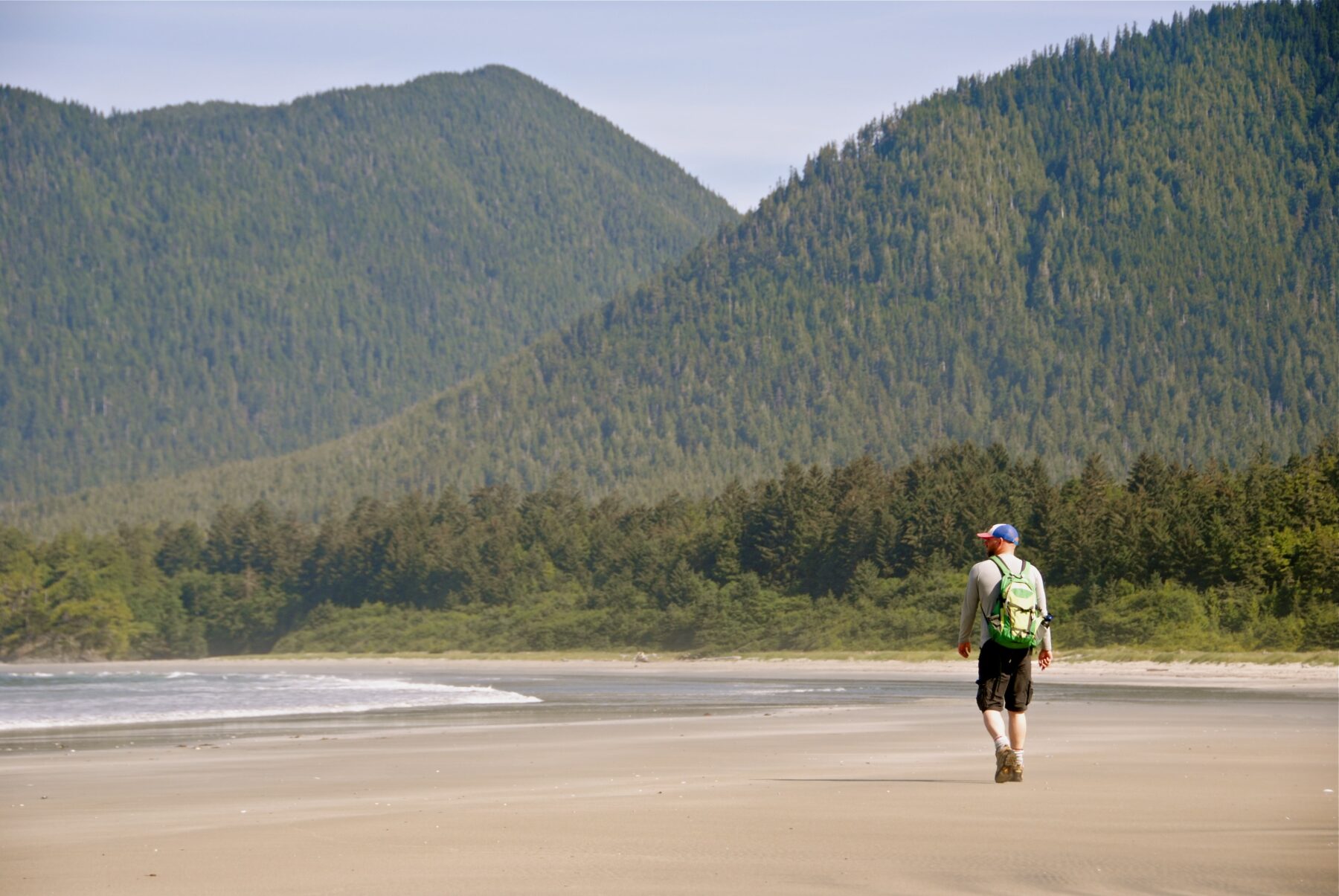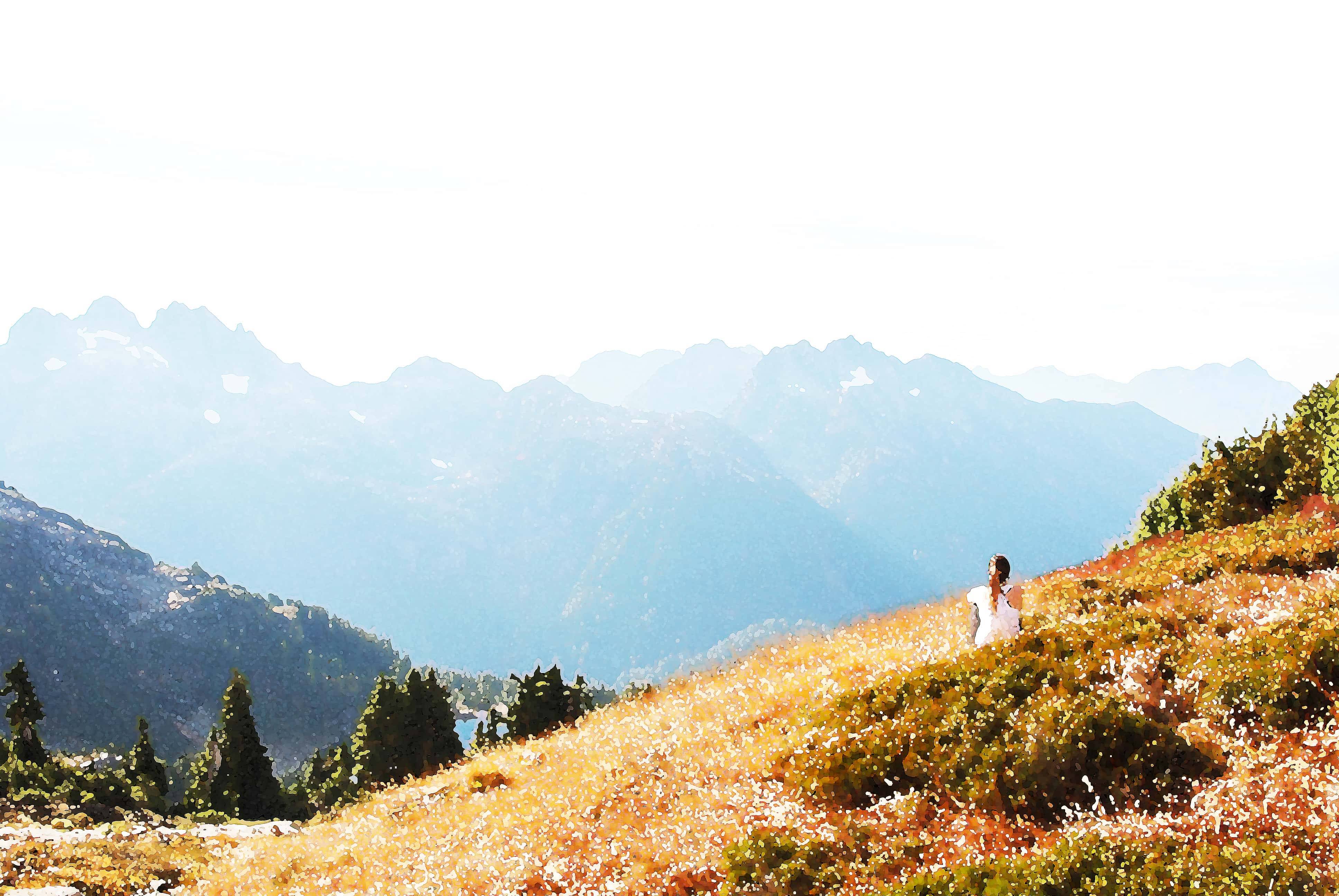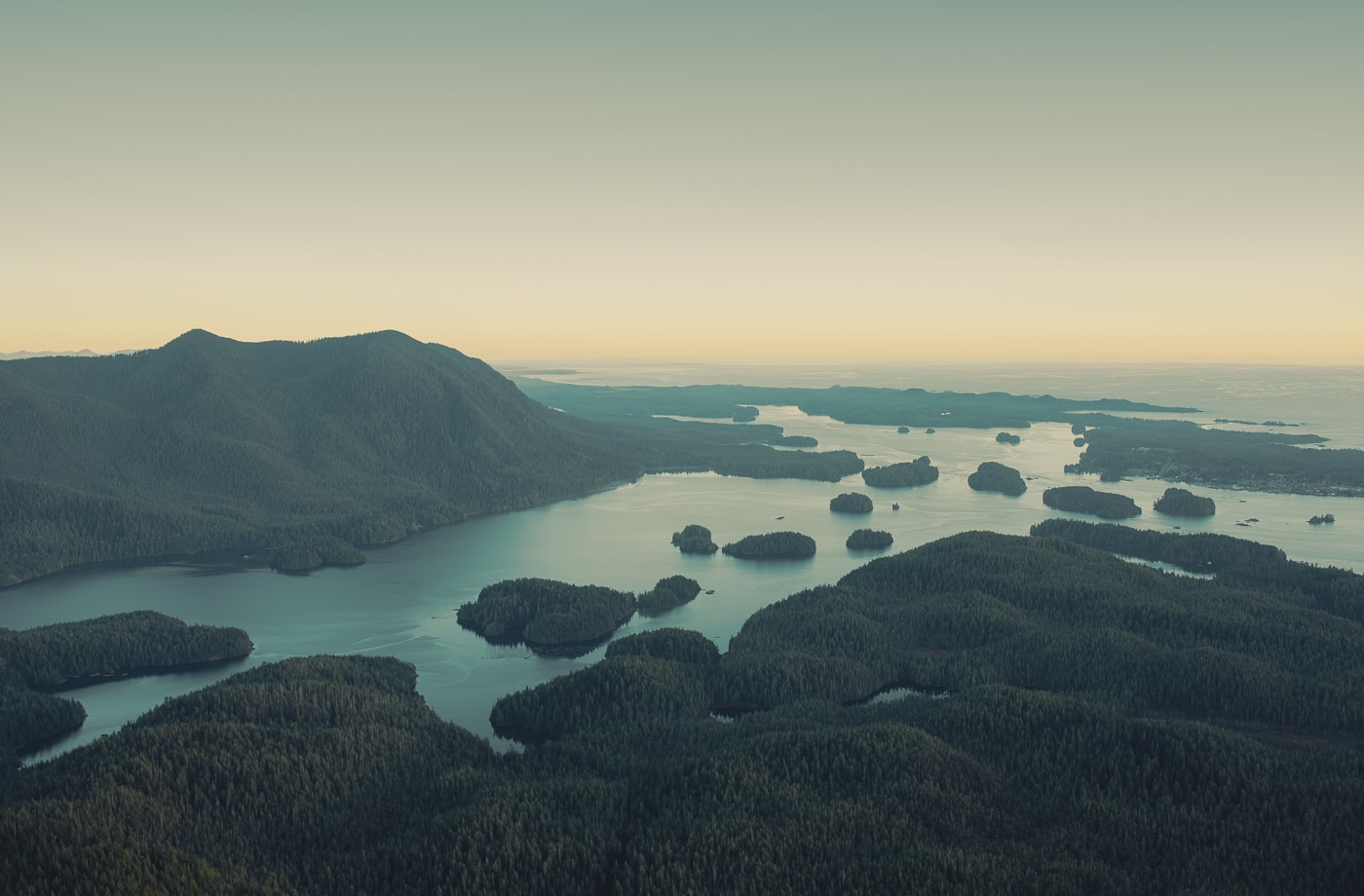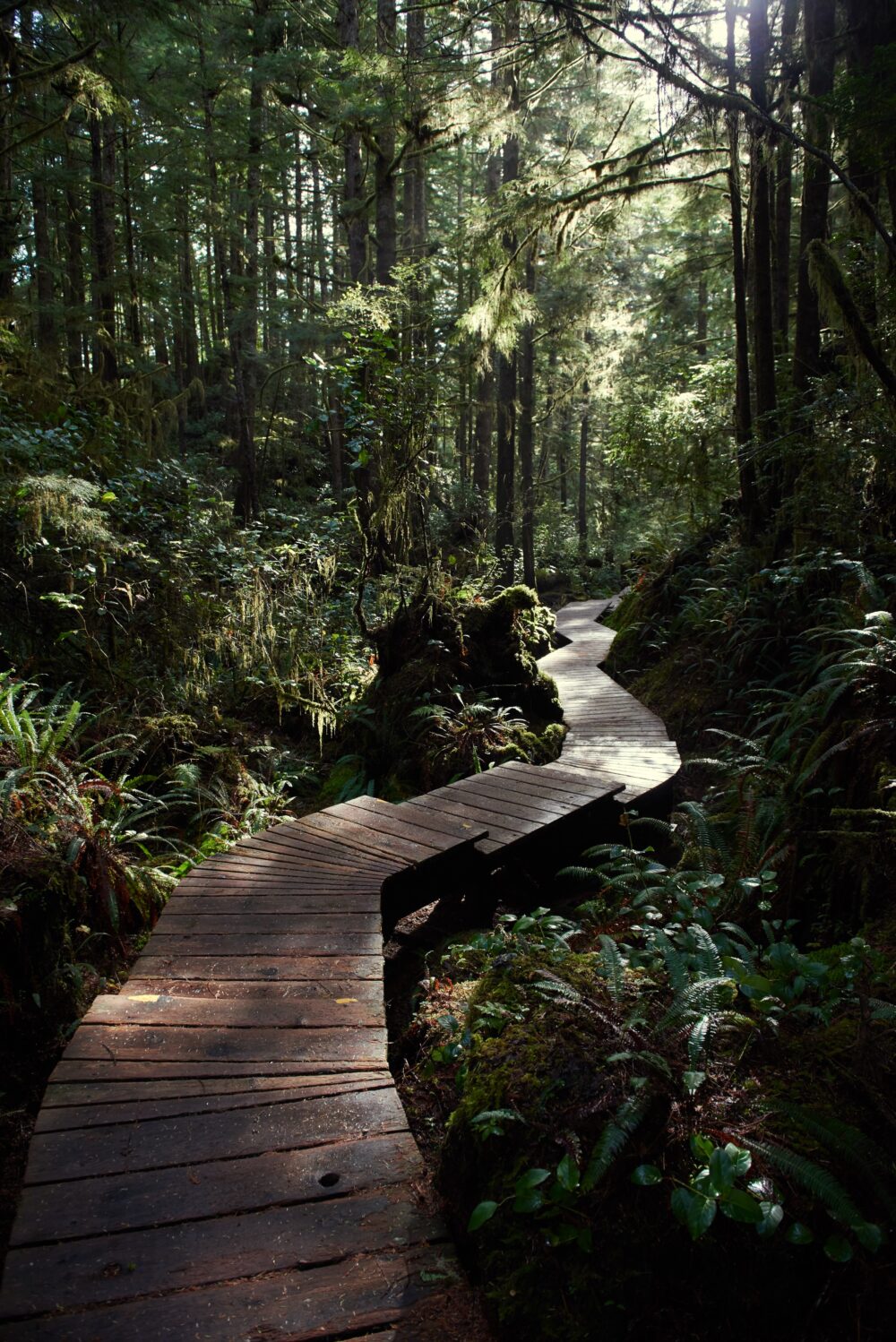An Ethical & Educational Approach to Wildlife Viewing
LONG BEACH
NATURE JOURNAL
HOME > LONG BEACH NATURE JOURNAL > An Ethical & Educational Approach to Wildlife Viewing
An Ethical & Educational Approach to Wildlife Viewing
Nestled within the breathtaking landscapes of British Columbia lies a wildlife viewing experience that brings visitors from all over the world with their telephoto lens in hand, excited to capture a glimpse of a bear in the wild. In various locations across the province, commercial bear viewing focuses on a variety of types of bears including grizzly bears (ursus arctos), the Spirit Bear or Kermode Bear (ursus americanus kermodei) and Vancouver Island’s Black Bear (ursus americaus vancouveri). BC is one of the world’s last places to see wild bears in their natural habitat.
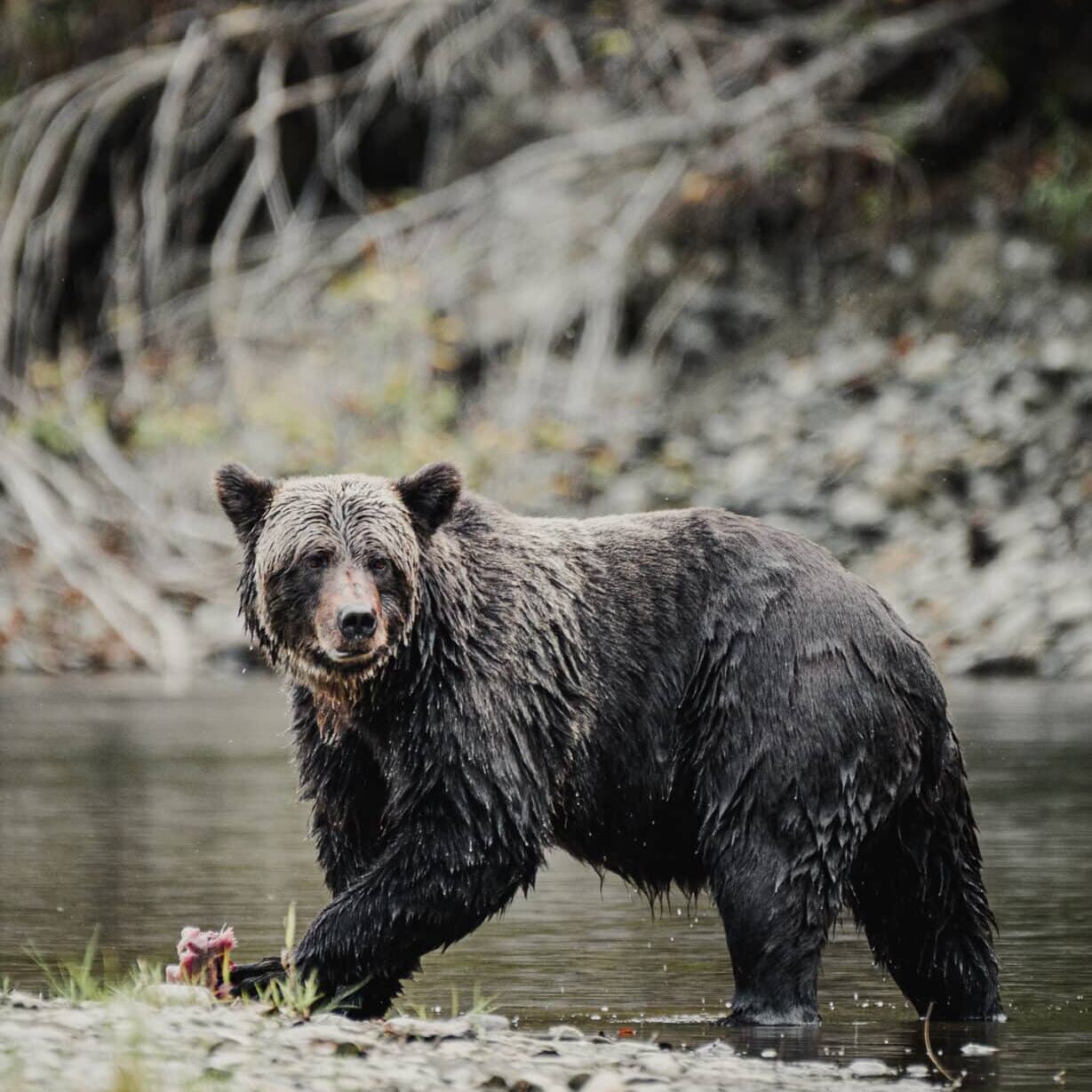
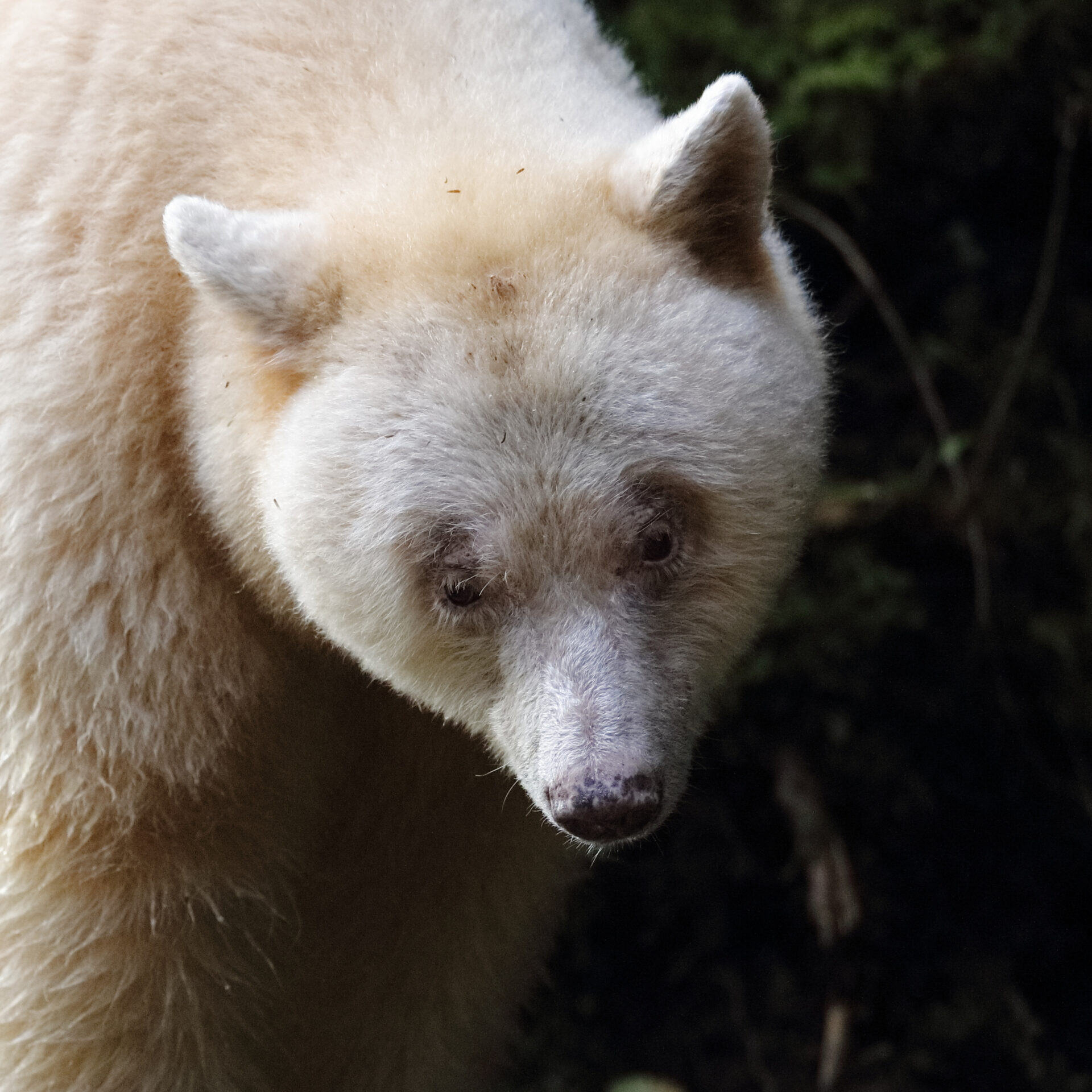
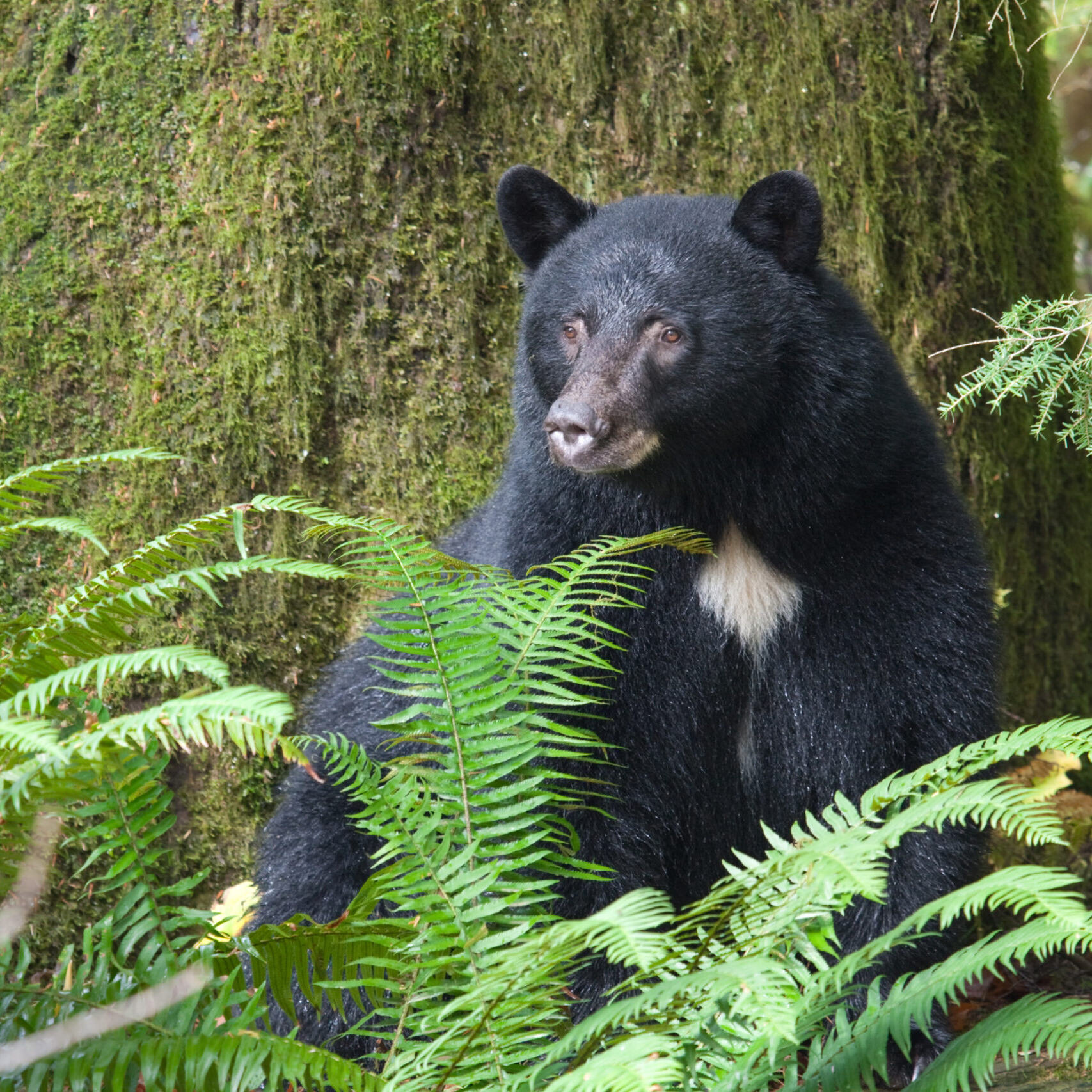
With the ever increasing pressure of tourism, the Commercial Bear Viewing Association of BC (CBVA) was formed to promote sustainable bear viewing in British Columbia and aid in the protection of wild bears and their ecosystems. According to the 2014 Global Report on Adventure Tourism by the World Tourism Organization, adventure travelers prioritize destinations with natural beauty, seeking out pristine, wild, and distinctive environments. However, as more tourists visit untouched natural areas without proper guidelines, it can distress animals and degrade their habitats. Responsible wildlife viewing requires individuals, groups, and tour operators to ensure their actions don't disrupt animals' normal behavior.
One of the key pillars of the CBVA's ethos is responsible tourism. Unlike traditional wildlife encounters that prioritize entertainment over conservation, the CBVA places the well-being of bears and their habitats at the forefront of every endeavor. By adhering to strict guidelines, and regulations, such as maintaining a safe distance from the bears and minimizing human impact on their environment, the association ensures that the welfare of the bears remains uncompromised.
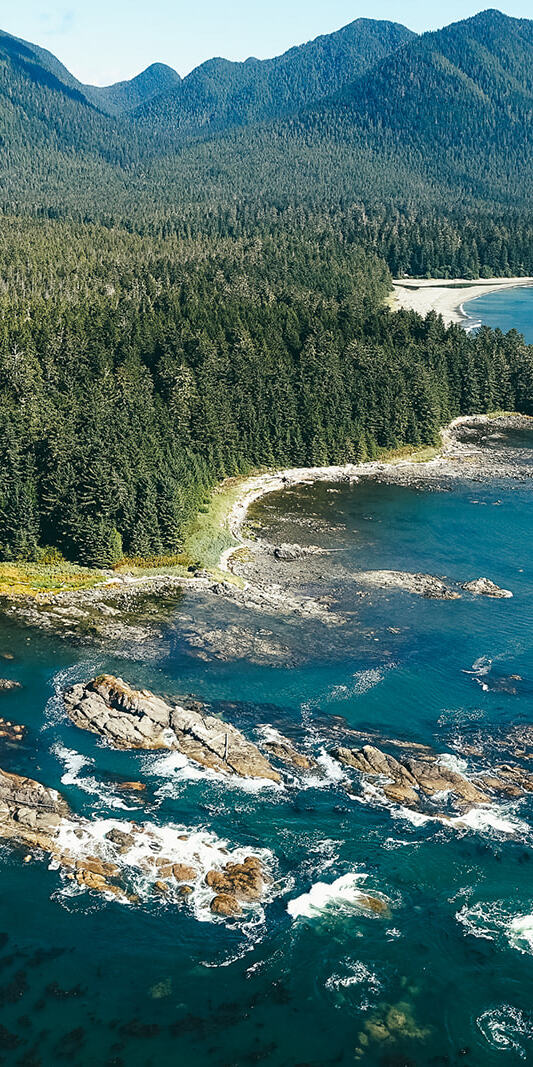
In natural environments, there's no guarantee of seeing animals, yet visitors often form unrealistic expectations from brochures and ads before even consulting tour operators. The media plays a significant role, showcasing thrilling images of close encounters with wildlife, like whales breaching beside kayaks or bears near humans, often with misleading narratives. This portrayal fuels the desire for risky "up close and personal" experiences. However, wild animals don't perform for humans as portrayed. Unfortunately, such sensationalized marketing encourages unethical wildlife viewing practices, leading to harm to animals, misinformation, and a challenge for ethical companies to counteract these narratives and guide consumers towards responsible choices.
The Commercial Bear Viewing Strategy
The CBVA established the Commercial Bear Viewing Strategy providing guidance and recommendations for bear viewing throughout the province. The strategy includes guidance for viewing bears in a way that reduces viewer’s influence on bears and the development of area-based viewing plans to ensure a healthy and sustainable wildlife tourism industry in British Columbia. This has also led to the development of The Grizzly Bear Stewardship Framework which is the first document of its kind in British Columbia, and has the potential to be world-leading in setting an example for how wildlife stewardship should be done. This Framework is “intended to provide guidance for the consideration of grizzly bear values for proponents, decision makers, and participants on initiatives related to land and resource planning to inform local decisions, and enables amendments to policy, legislation, and programs related to grizzly bears.” The Framework will support the preparation of regional grizzly bear stewardship plans.
The CBVA established the Commercial Bear Viewing Strategy providing guidance and recommendations for bear viewing throughout the province. The strategy includes guidance for viewing bears in a way that reduces viewer’s influence on bears and the development of area-based viewing plans to ensure a healthy and sustainable wildlife tourism industry in British Columbia. This has also led to the development of The Grizzly Bear Stewardship Framework which is the first document of its kind in British Columbia, and has the potential to be world-leading in setting an example for how wildlife stewardship should be done. This Framework is “intended to provide guidance for the consideration of grizzly bear values for proponents, decision makers, and participants on initiatives related to land and resource planning to inform local decisions, and enables amendments to policy, legislation, and programs related to grizzly bears.” The Framework will support the preparation of regional grizzly bear stewardship plans.
In conclusion, the Commercial Bear Viewing Association of BC stands as a shining example of responsible wildlife tourism. By prioritizing conservation, education, and community engagement, the CBVA is paving the way for a more sustainable approach to bear viewing. Through their efforts, visitors are not only treated to awe-inspiring encounters with bears but are also empowered to become advocates for their protection and preservation. In a world where wildlife faces unprecedented threats, organizations like the CBVA, their certified members and guides, serve as beacons of hope, reminding us of the importance of coexisting harmoniously with the natural world. The Wilderness Tourism Association of British Columbia emphasizes the importance of environmental responsibility in wilderness tourism across the province. They stress that operators are increasingly adopting practices to sustain both the industry and the natural environment it relies upon. With the growing number of tour operators in British Columbia, it's crucial for visitors interested in wildlife viewing to conduct thorough research. A trustworthy tour operator will not only follow guidelines for responsible wildlife viewing but also educate guests on why these practices matter. When inquiring about tours, visitors should consider factors such as guide training, qualifications, company principles, and approach. For those interested in wildlife photography, operators should highlight the benefits of using cameras with zoom or telephoto lenses to adhere to minimum distance regulations, and they should always provide binoculars for viewing.
In conclusion, the Commercial Bear Viewing Association of BC stands as a shining example of responsible wildlife tourism. By prioritizing conservation, education, and community engagement, the CBVA is paving the way for a more sustainable approach to bear viewing. Through their efforts, visitors are not only treated to awe-inspiring encounters with bears but are also empowered to become advocates for their protection and preservation. In a world where wildlife faces unprecedented threats, organizations like the CBVA, their certified members and guides, serve as beacons of hope, reminding us of the importance of coexisting harmoniously with the natural world. The Wilderness Tourism Association of British Columbia emphasizes the importance of environmental responsibility in wilderness tourism across the province. They stress that operators are increasingly adopting practices to sustain both the industry and the natural environment it relies upon. With the growing number of tour operators in British Columbia, it's crucial for visitors interested in wildlife viewing to conduct thorough research. A trustworthy tour operator will not only follow guidelines for responsible wildlife viewing but also educate guests on why these practices matter. When inquiring about tours, visitors should consider factors such as guide training, qualifications, company principles, and approach. For those interested in wildlife photography, operators should highlight the benefits of using cameras with zoom or telephoto lenses to adhere to minimum distance regulations, and they should always provide binoculars for viewing.

Before you book your next BC bear viewing adventure tour, ensure that the tour company you choose is a member of the CBVA and the guides they employ are certified. Be sure to visit our member page to see what the possibilities might be for your next adventure in the company of wild bears!Visit https://www.bearviewing.ca/ to learn more.
Our Guide to Tofino: Welcome to the West Coast
LONG BEACH
NATURE JOURNAL
HOME > LONG BEACH NATURE JOURNAL > Our Guide to Tofino: Welcome to the West Coast
Our Guide to Tofino: Welcome to the West Coast
Nestled on the rugged west coast of Vancouver Island, Tofino is a small but enchanting destination that has captured the hearts of travelers from around the world. Known for its stunning natural beauty, thriving arts scene, and laid-back vibe, Tofino offers a unique and unforgettable experience for those seeking a getaway that combines relaxation and adventure.
Whether you're a nature enthusiast, a foodie, a surfer, or simply looking to escape the hustle and bustle of city life, Tofino has something to offer everyone. In this comprehensive guide to Tofino, we'll take you on a virtual journey through this coastal gem, highlighting its must-see attractions, outdoor adventures, culinary delights, and more.
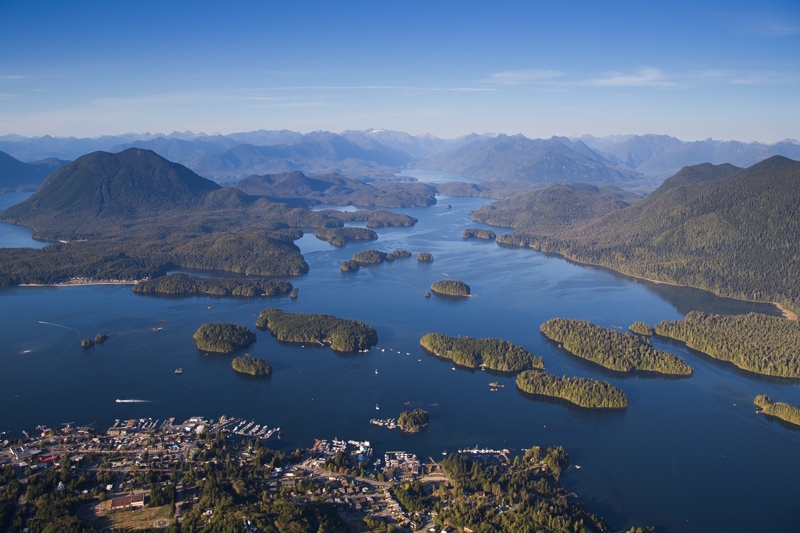
Getting Here
Before we dive into all the wonders Tofino has to offer, let's talk about how to get there. Tofino is located on Vancouver Island, and the most common way to reach it is by taking a ferry from the mainland of British Columbia. The ferry ride itself is a scenic experience, as you'll sail through the picturesque Gulf Islands before arriving on Vancouver Island.
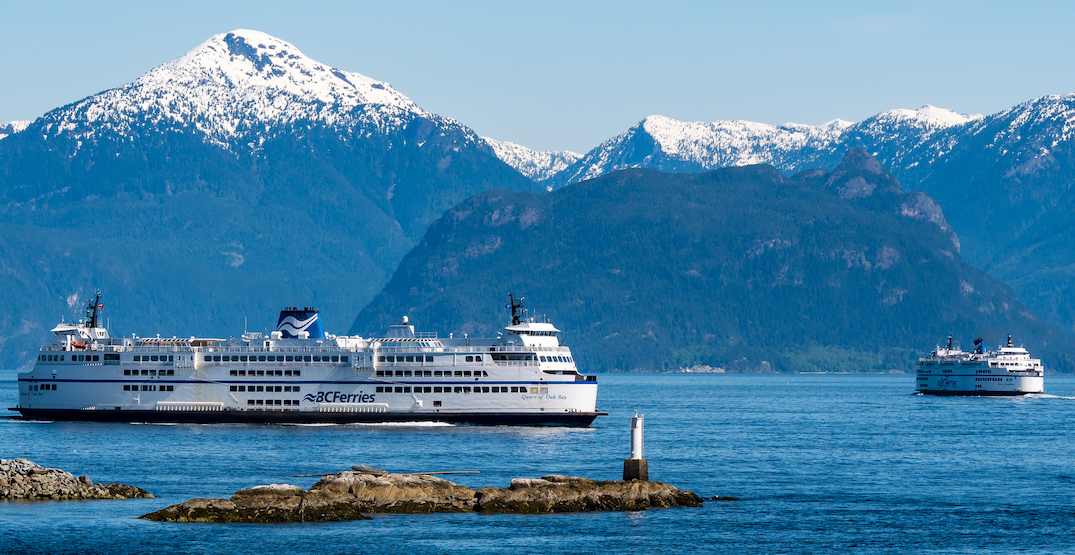
Once you arrive on the island, you can drive to Tofino, which is approximately a 4-5 hour journey from Victoria, the capital of British Columbia or a 3-4 hour drive from Nanaimo if you take the Horseshoe Bay - Departure Bay ferry. If you prefer a quicker route, you can take a domestic flight from Vancouver to Tofino's small airport. Regardless of your mode of transportation, the journey to Tofino is part of the adventure, offering glimpses of the stunning landscapes that await you.
Where to Stay
Tofino offers a wide range of accommodation options, catering to different preferences and budgets. Whether you're seeking a luxurious beachfront resort, a cozy cabin in the woods, or a budget-friendly hostel, you'll find something that suits your needs.
Beachfront Resorts: Tofino is home to some of the most luxurious beachfront resorts in Canada. Wake up to the soothing sound of waves crashing just outside your window and enjoy top-notch amenities, spa treatments, and exquisite dining. Cabin Retreats: For a more rustic experience, consider staying in one of the many cabins or cottages tucked away in the lush rainforest. These accommodations provide a sense of seclusion while still being close to town. Cozy Bed and Breakfasts: Tofino is known for its charming bed and breakfasts, offering warm hospitality and a chance to connect with the locals. Hostels and Campgrounds: Budget travelers will find affordable hostels and campgrounds that allow them to experience Tofino's natural beauty without breaking the bank.
Tofino offers a wide range of accommodation options, catering to different preferences and budgets. Whether you're seeking a luxurious beachfront resort, a cozy cabin in the woods, or a budget-friendly hostel, you'll find something that suits your needs.
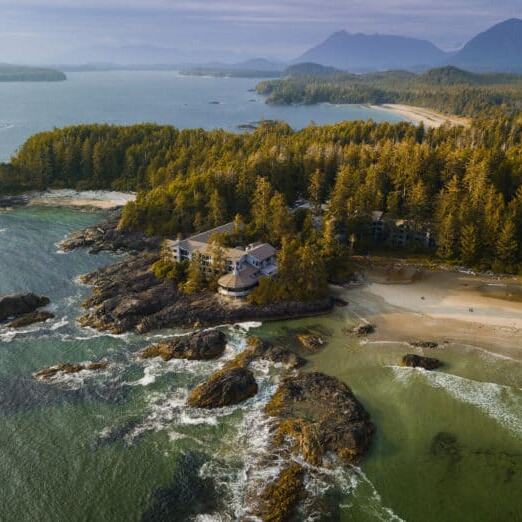
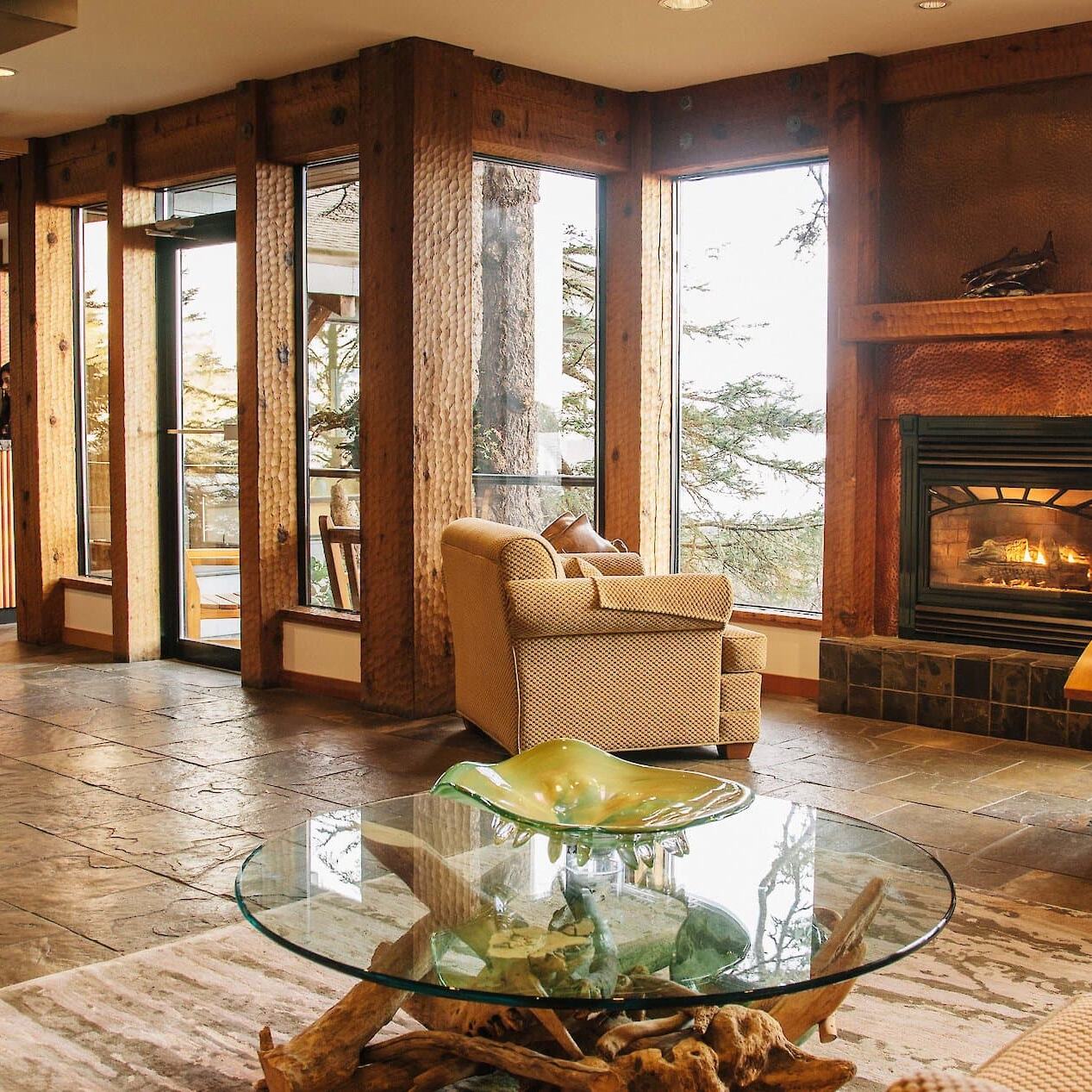
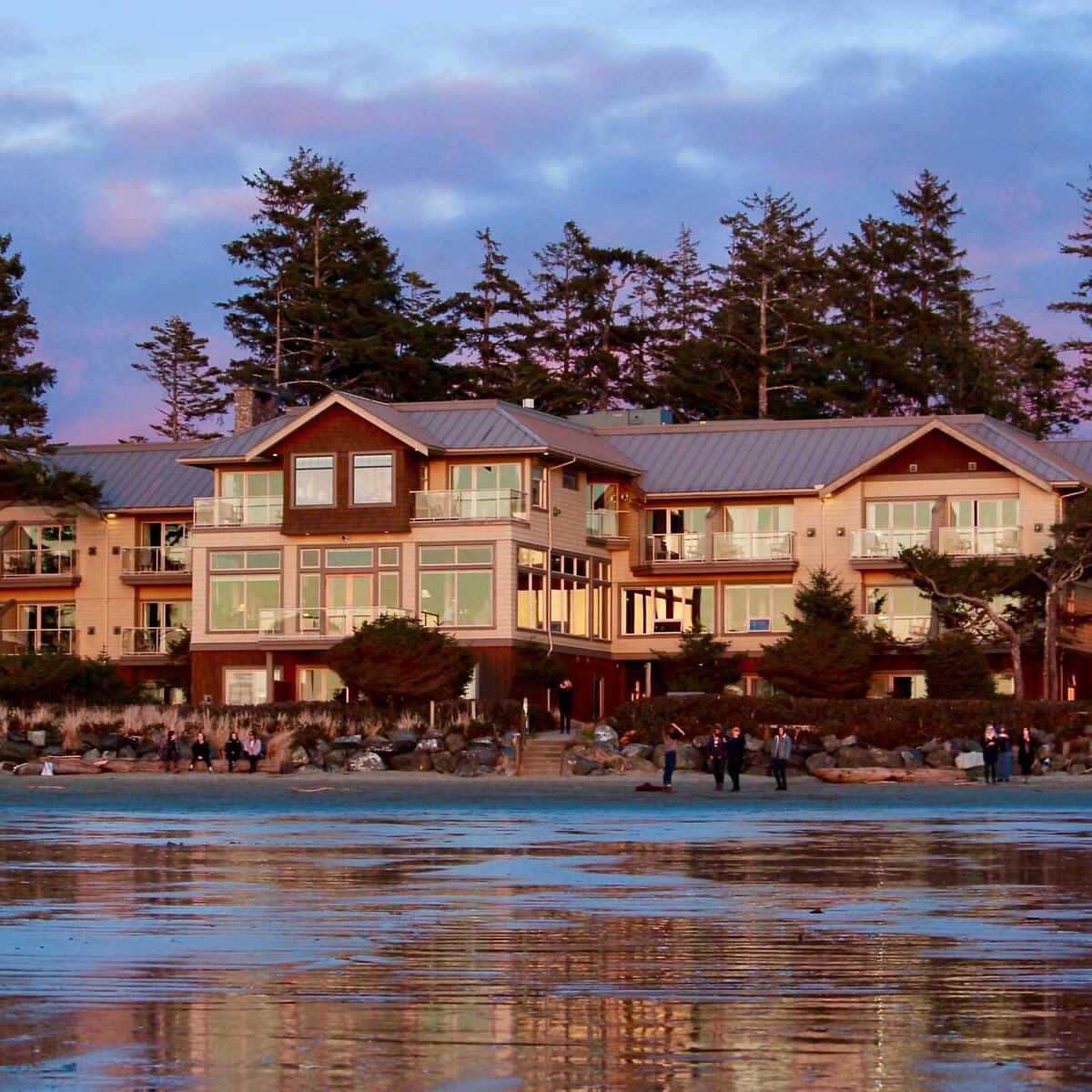
Things to Do and See
Tofino is a haven for outdoor enthusiasts and nature lovers. Here are some of the top attractions and activities that should be on your Tofino itinerary:
Pacific Rim National Park Reserve: Explore the pristine beaches, lush rainforests, and rugged coastline of this national park. Hike along the Wild Pacific Trail, visit the famous Long Beach, and keep an eye out for wildlife like whales and sea otters. Surfing: Tofino is a world-renowned surf destination, attracting surfers of all skill levels. Whether you're a seasoned pro or a beginner, there are surf schools and rental shops to help you catch some waves. Hot Springs Cove: Take a boat or seaplane ride to Hot Springs Cove, where you can soak in natural hot springs while overlooking the Pacific Ocean. Whale Watching: Tofino is a prime spot for whale watching, especially from March to October. Join a whale-watching tour to spot gray whales, orcas, humpbacks, and more. Cultural Experiences: Explore Tofino's rich Indigenous culture by visiting local art galleries, attending cultural events, and learning about the history and traditions of the Nuu-chah-nulth people.
Tofino is a haven for outdoor enthusiasts and nature lovers. Here are some of the top attractions and activities that should be on your Tofino itinerary:
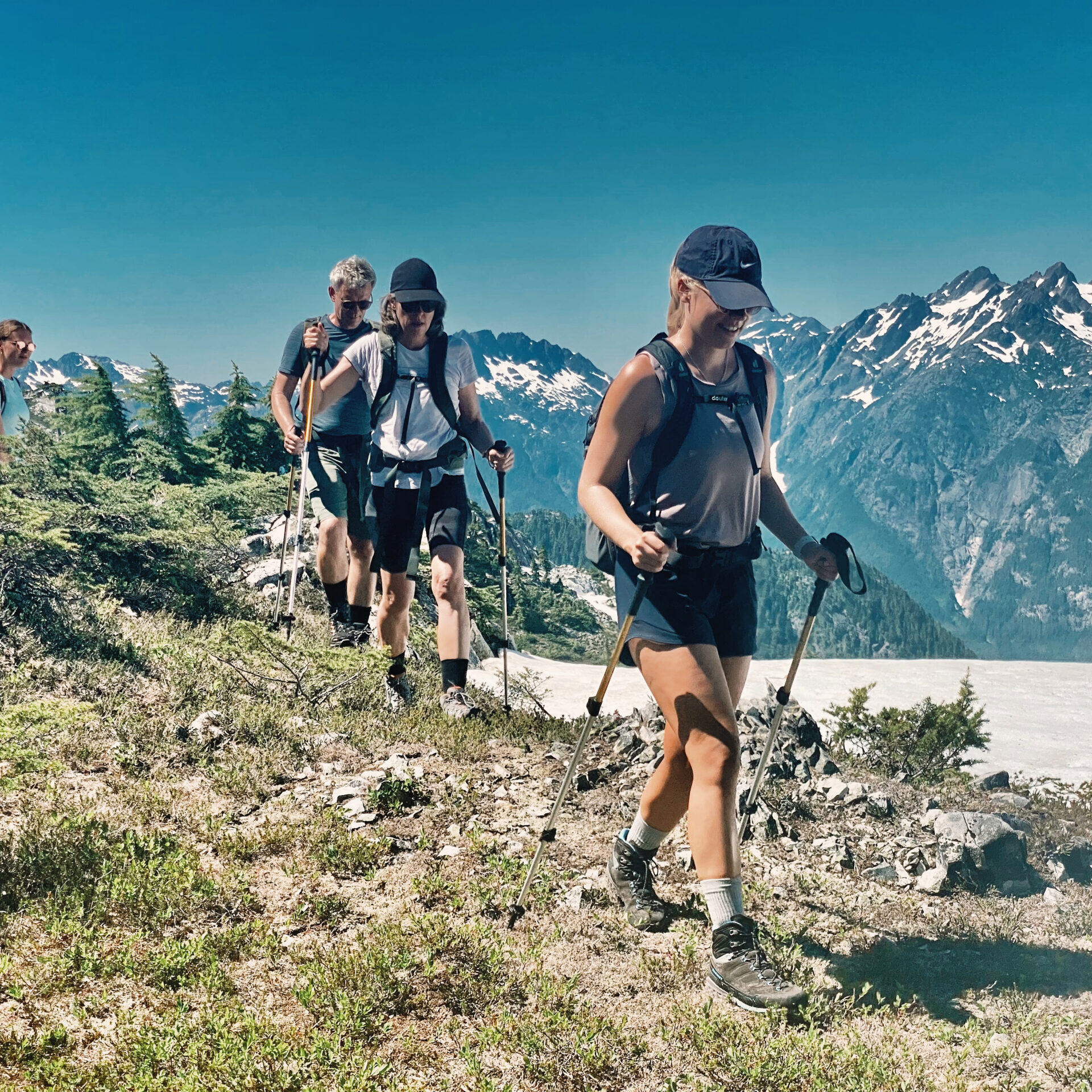
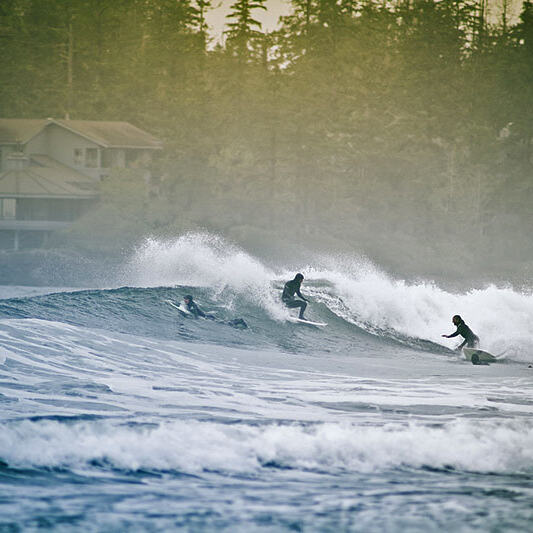
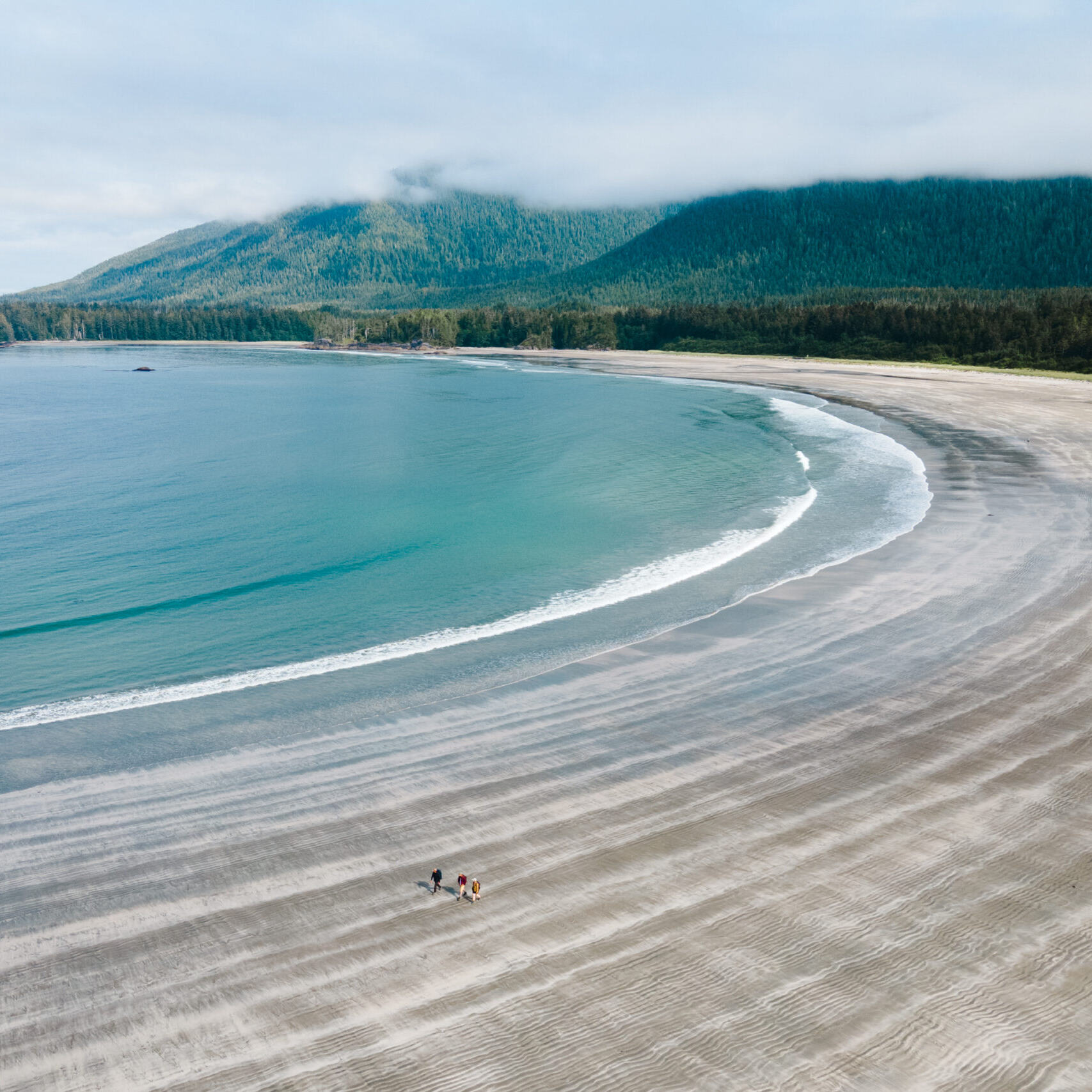
Dinning and Culinary Delights
Tofino's culinary scene is a delightful blend of fresh seafood, locally sourced ingredients, and innovative cuisine. Here are some dining experiences you won't want to miss:
Seafood Galore: Tofino is famous for its seafood, and you can savor the freshest catches of the day at restaurants like The Pointe at the Wickaninnish Inn and Wolf in the Fog. Farm-to-Table: Many restaurants in Tofino embrace the farm-to-table philosophy, showcasing the best of Vancouver Island's produce. Don't miss the opportunity to dine at places like SoBo (Short for "Sophisticated Bohemian") and Shelter. Food Trucks and Casual Eateries: For a more laid-back experience, try the local food trucks and casual eateries that serve up delicious tacos, fish and chips, and other treats. Craft Beer and Spirits: Tofino's craft beer scene is thriving, and you can sample local brews at the Tofino Brewing Company and other breweries in the area.
Tofino's culinary scene is a delightful blend of fresh seafood, locally sourced ingredients, and innovative cuisine. Here are some dining experiences you won't want to miss:
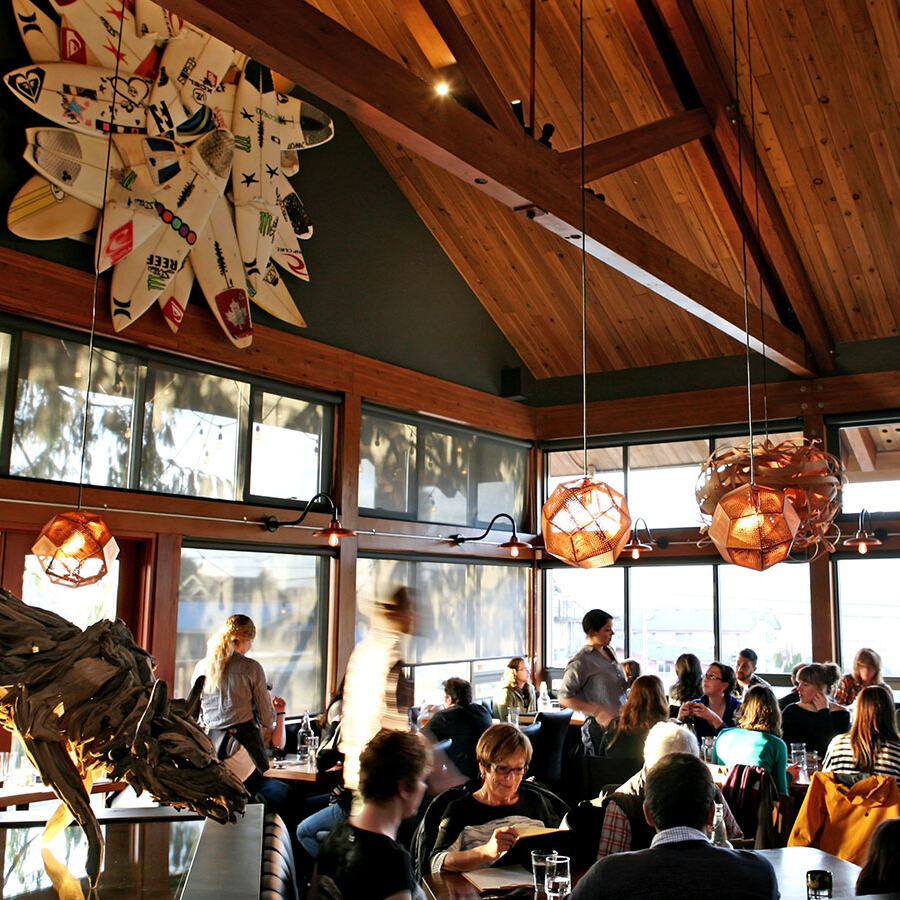
Tofino Arts and Culture Scene
Tofino's vibrant arts scene is a testament to the town's creative spirit. Explore local art galleries and studios, attend live music performances, and immerse yourself in the artistic essence of this coastal community. Don't forget to check out the Tofino Public Market if you happen to visit during the summer months; it's a great place to discover local crafts and artisanal products.
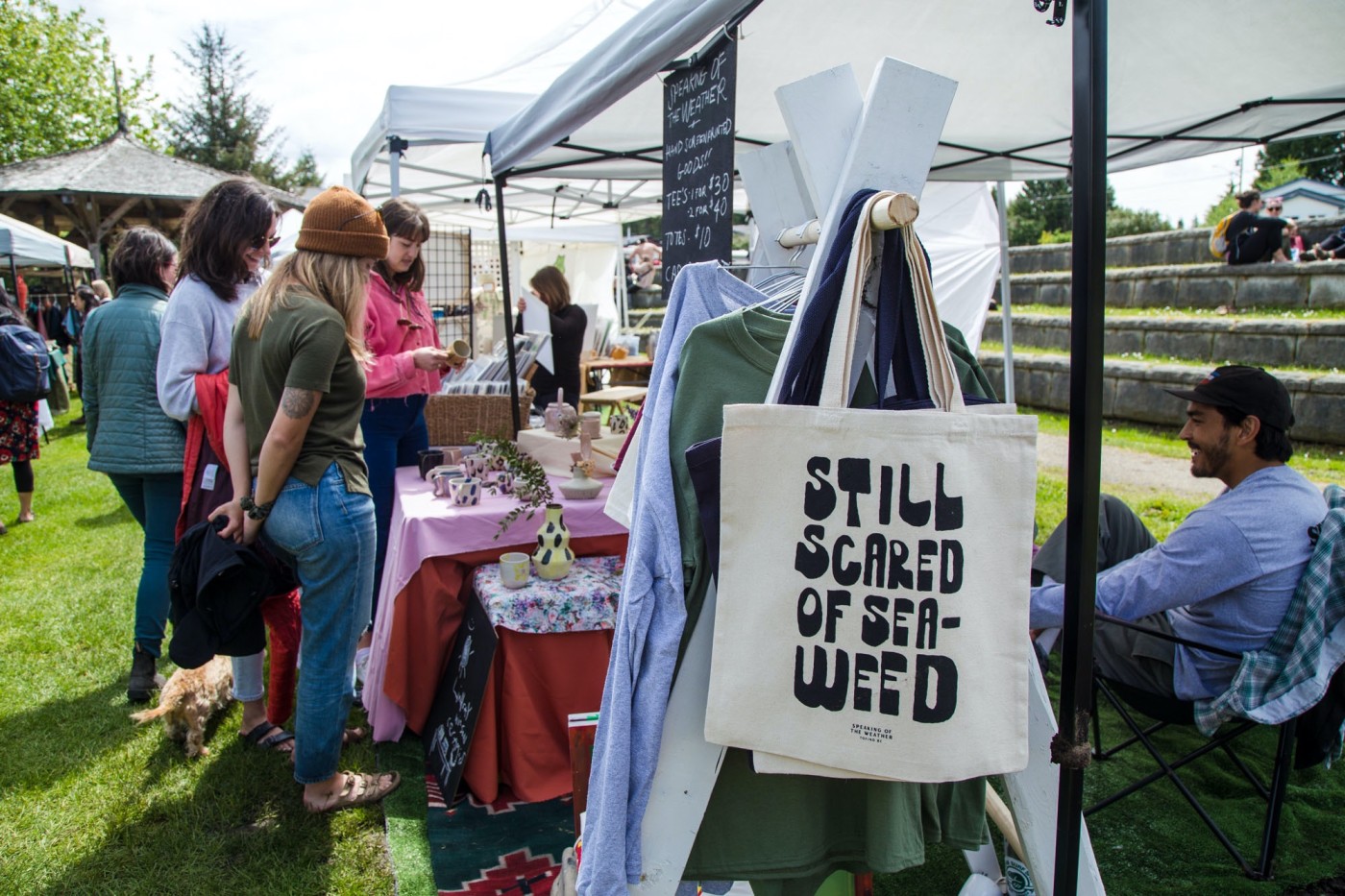
Tofino, with its breathtaking natural beauty, outdoor adventures, culinary delights, and rich cultural scene, is a place that leaves a lasting impression on all who visit. Whether you're seeking relaxation, adventure, or a bit of both, Tofino welcomes you with open arms to experience the magic of the West Coast. So pack your bags, embrace the coastal lifestyle, and get ready for an unforgettable journey in this Pacific paradise.Visit https://tourismtofino.com/ to learn more.
Search
Recent Posts
Categories
10 Things You Need To Know Before Visiting Vancouver Island
LONG BEACH
NATURE JOURNAL
HOME > LONG BEACH NATURE JOURNAL > 10 Things You Should Know Before Visiting Vancouver Island
10 Things You Should Know Before Visiting Vancouver Island
Vancouver Island, located off the southwestern coast of British Columbia, Canada, is a mesmerizing destination that beckons travelers with its stunning natural beauty, diverse wildlife, and vibrant communities. Whether you're a nature enthusiast, an adventure seeker, or a culture lover, Vancouver Island has something to offer everyone. But before you pack your bags and head to this Pacific paradise, there are some essential things you should know to make the most of your visit. In this comprehensive guide, we'll explore ten crucial tips that will help you plan a memorable trip to Vancouver Island.
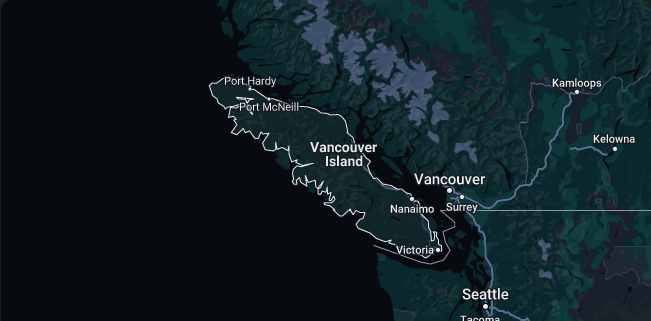
Geography & Location
Vancouver Island is a large island located off the southwest coast of Canada. Situated in the Pacific Ocean, it is separated from the mainland of British Columbia by the Strait of Georgia to the east and the Johnstone Strait to the north. The island is approximately 460 kilometers (290 miles) in length and 80 kilometers (50 miles) in width, making it the largest island on the west coast of North America. Vancouver Island is known for its diverse geography, which includes mountains, forests, and coastal areas. The island's landscape is characterized by the rugged beauty of the Vancouver Island Ranges, with the highest peak being Golden Hinde. The city of Victoria, the capital of British Columbia, is located on the southern tip of the island. Vancouver Island is not only celebrated for its natural beauty but also for its vibrant communities, outdoor recreational opportunities, and rich cultural heritage.
Vancouver Island is not to be confused with the city of Vancouver, which is on the mainland. The island is separated from the mainland by the Strait of Georgia, and the only way to reach it is by ferry, seaplane, or boat. Be sure to plan your transportation accordingly and check the ferry schedules, as they can vary depending on the season.
Diverse Climate Zones
Vancouver Island, located off the southwestern coast of Canada, features a diverse range of climate zones due to its varied topography and proximity to the Pacific Ocean. The island's climate is primarily influenced by the Pacific maritime conditions, resulting in mild, wet winters and relatively dry summers. The eastern side of the island, including areas like Nanaimo and Victoria, experiences a Mediterranean-like climate with warm, dry summers and cool, wet winters. In contrast, the western and northern regions, such as Tofino and Port Hardy, are characterized by a temperate rainforest climate, receiving abundant rainfall and maintaining mild temperatures throughout the year. The central mountainous areas exhibit an alpine climate, with cooler temperatures and the possibility of snowfall in winter. This rich tapestry of climate zones on Vancouver Island contributes to its lush landscapes and diverse ecosystems.
Vancouver Island, located off the southwestern coast of Canada, features a diverse range of climate zones due to its varied topography and proximity to the Pacific Ocean. The island's climate is primarily influenced by the Pacific maritime conditions, resulting in mild, wet winters and relatively dry summers. The eastern side of the island, including areas like Nanaimo and Victoria, experiences a Mediterranean-like climate with warm, dry summers and cool, wet winters. In contrast, the western and northern regions, such as Tofino and Port Hardy, are characterized by a temperate rainforest climate, receiving abundant rainfall and maintaining mild temperatures throughout the year. The central mountainous areas exhibit an alpine climate, with cooler temperatures and the possibility of snowfall in winter. This rich tapestry of climate zones on Vancouver Island contributes to its lush landscapes and diverse ecosystems.
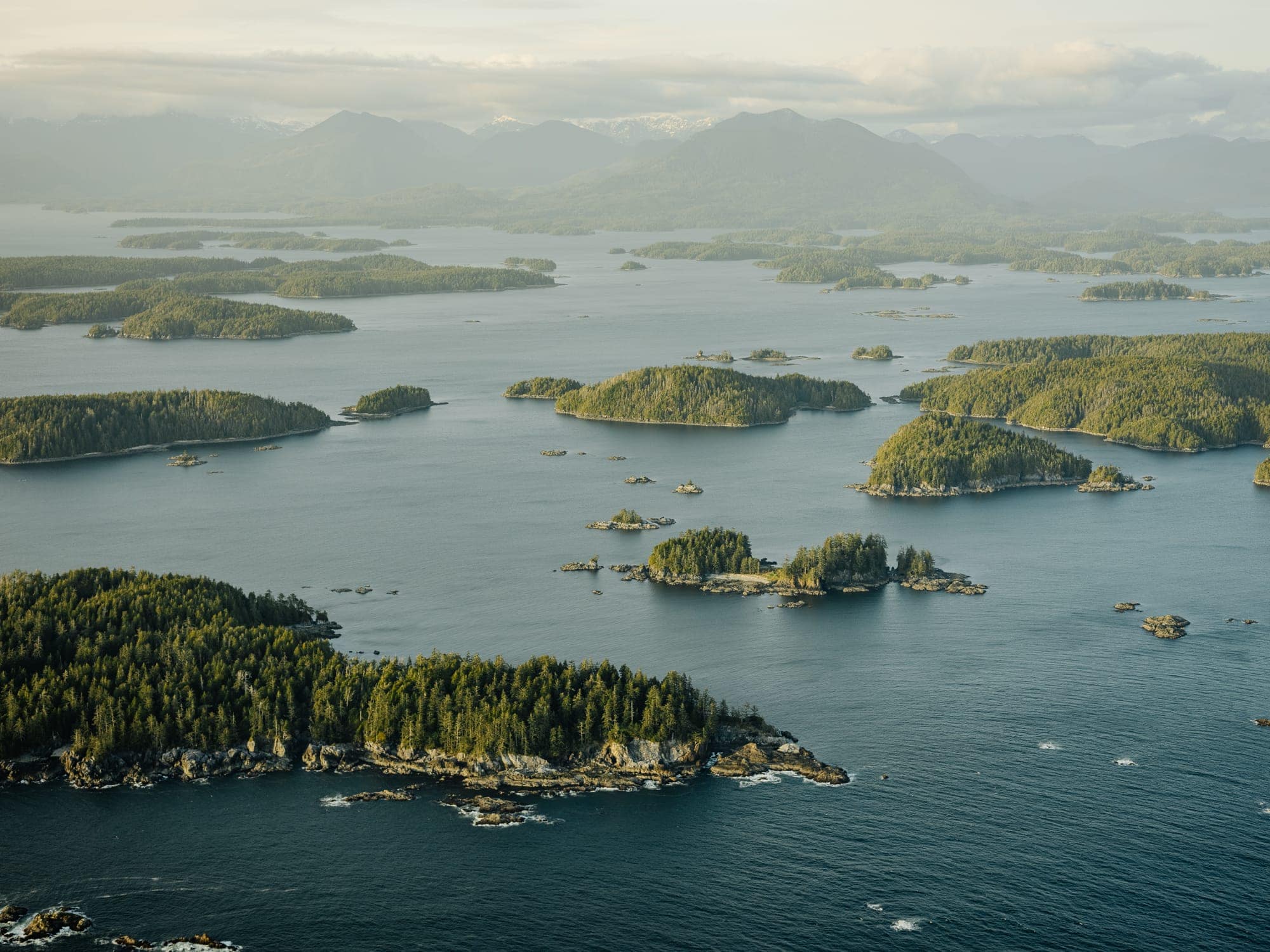
Wildlife
The island's temperate rainforests, rugged coastlines, and pristine waters provide a habitat for an abundance of species. Towering conifers shelter a variety of birds, including bald eagles, herons, and songbirds, while the surrounding waters are teeming with marine life such as orcas, gray whales, humpback whales, seals, sea lions and sea otters. The island's forests are home to elusive mammals like black bears, cougars, deer and elk, and its rivers support spawning salmon during their remarkable journeys. Vancouver Island's commitment to conservation and preservation efforts ensures the continued thriving of its unique and captivating wildlife, making it a haven for nature enthusiasts and a testament to the region's ecological importance. If you plan on hiking or exploring the outdoors, it's essential to be bear-aware and follow wildlife safety guidelines.
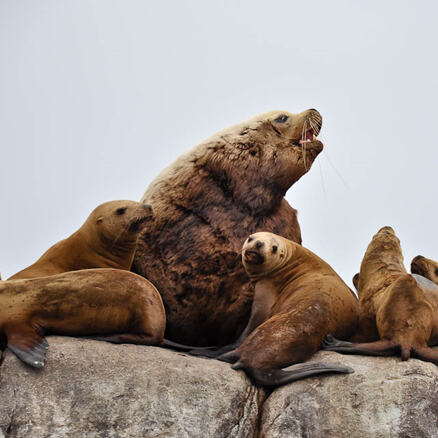

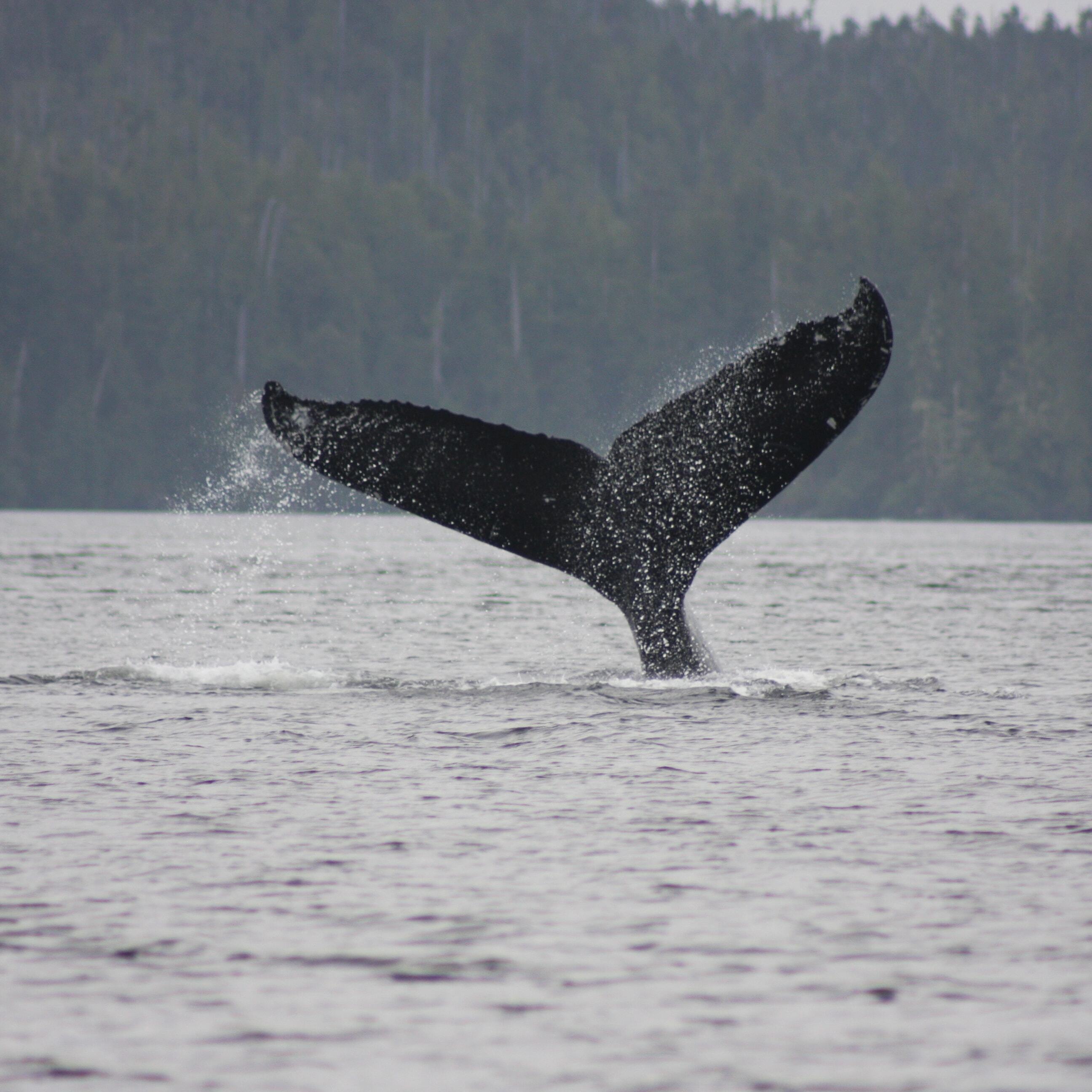
Outdoor Adventures
For outdoor enthusiasts, Vancouver Island is a dream destination. From the rugged trails of Strathcona Provincial Park, where hikers can explore alpine meadows and pristine lakes, to the exhilarating waves of Tofino, attracting surfers and beachcombers alike. Kayaking through the serene waters of Desolation Sound or whale-watching off the coast provides a close encounter with the island's abundant marine life. The West Coast Trail beckons those seeking a challenging backpacking experience along the wild Pacific shoreline. With its lush rainforests, snow-capped peaks, and abundant wildlife, Vancouver Island promises unforgettable outdoor escapades for adventurers of all stripes.

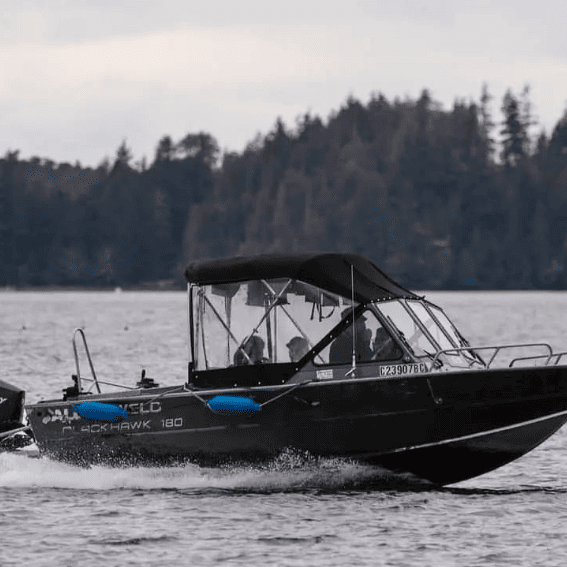
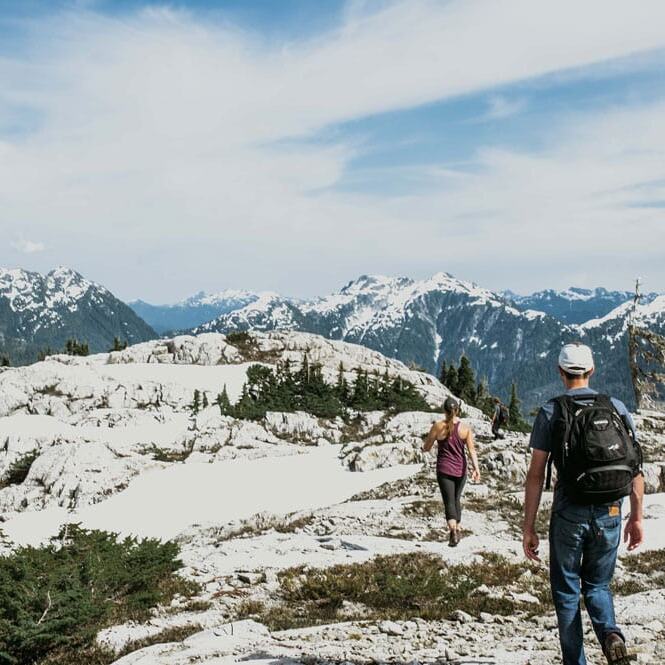
Indigenous Culture
The indigenous culture of Vancouver Island is rich and diverse, reflecting the deep connection of the region's First Nations to the land and sea. The island is home to several indigenous groups, including the Coast Salish, Nuu-chah-nulth, and Kwakwaka'wakw, each with its own distinct traditions, languages, and artistic styles. Traditional practices such as potlatches, cedar weaving, and the creation of totem poles play a significant role in preserving and passing on cultural heritage. The lush natural surroundings of Vancouver Island have influenced indigenous beliefs and practices, emphasizing a harmonious relationship between humans and nature. Today, efforts are being made to revitalize indigenous languages, celebrate cultural events, and promote a deeper understanding and appreciation of the enduring traditions that shape the identity of the First Nations communities on Vancouver Island.Interested in learning more about British Columbia's Indigenous culture? Visit https://www.indigenousbc.com/ to learn more.
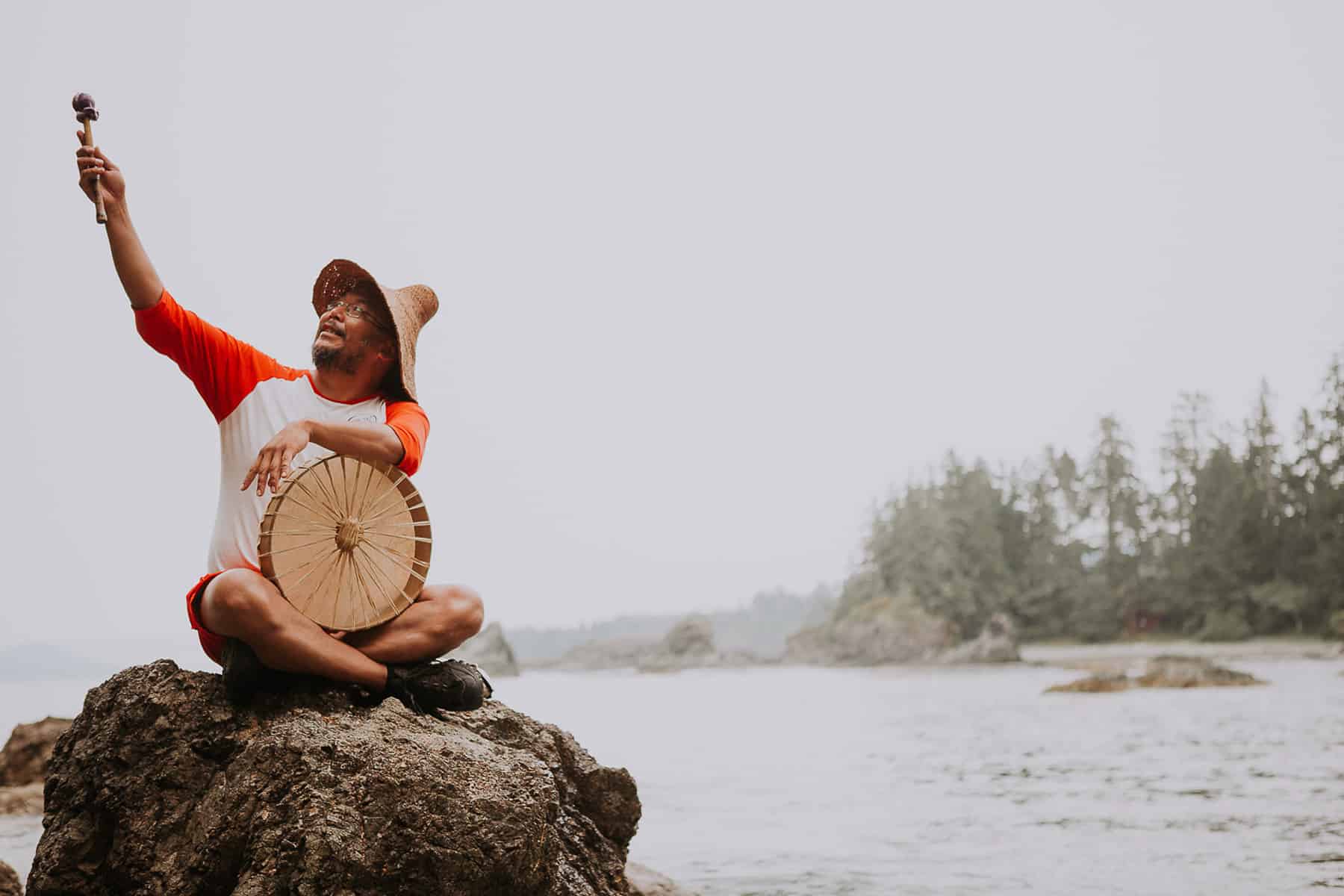
Marine Life Conservation
The island's marine ecosystem is fragile and vital. When participating in water-based activities be mindful of marine life and follow sustainable practices. Many areas have designated marine protected areas, so familiarize yourself with these zones and respect their regulations.
Island Hopping
Vancouver Island isn't the only gem in this region. Consider exploring nearby islands like Quadra Island, Hornby Island, Salt Spring Island, Galiano Island and more each offering unique experiences and natural beauty. Ferries and water taxis can take you on these exciting island-hopping adventures.
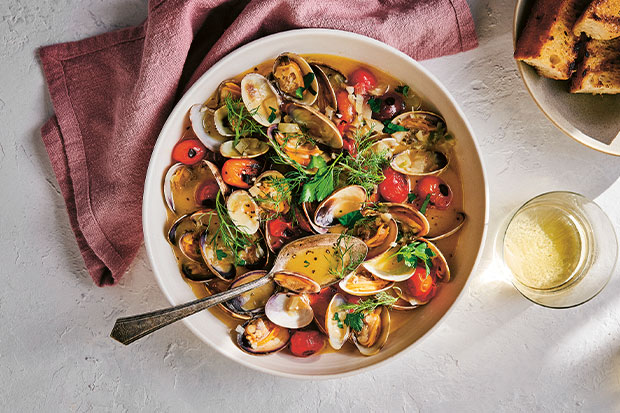
Culinary Delights
The island's culinary scene is a delightful surprise. From farm-to-table restaurants to seafood shacks, Vancouver Island offers a wide range of dining experiences. Try the local seafood, including Dungeness crab and Pacific salmon, and don't forget to sample wines from the island's burgeoning wine region.
Pacific Rainforest
Towering Douglas fir, Western red cedar, and Sitka spruce trees dominate the landscape, forming a dense canopy that creates a unique and enchanting ecosystem. The forest floor is adorned with a vibrant tapestry of mosses, ferns, and other understorey vegetation, contributing to the overall biodiversity. Visitors are treated to an immersive experience in a truly magical environment where the interplay of mist, towering trees, and the soothing sounds of nature create an unforgettable and awe-inspiring atmosphere.
Sustainable Travel
Last but not least, practice sustainable and responsible tourism when visiting Vancouver Island. Respect nature, follow Leave No Trace principles, and reduce your environmental impact. Many businesses on the island prioritize sustainability, so support eco-friendly initiatives during your stay.
Vancouver Island is a destination that offers a diverse range of experiences, from outdoor adventures to cultural exploration. By keeping these ten essential tips in mind, you can ensure a memorable and responsible visit to this breathtaking corner of the world. Enjoy the natural beauty, wildlife encounters, and cultural richness that Vancouver Island has to offer, and leave with cherished memories that will last a lifetime.Visit https://vancouverisland.travel/ to learn more.
Search
Recent Posts
Categories
Bear Watching on the West Coast of Vancouver Island
LONG BEACH
NATURE JOURNAL
HOME > LONG BEACH NATURE JOURNAL > BEAR WATCHING ON THE WEST COAST OF VANCOUVER ISLAND
Bear Watching on the West Coast of Vancouver Island
Canada is home to 60% of the world's bear population, and Tofino offers some of the best opportunities in the world to watch these stunning mammals in their natural habitat at a safe distance.
Vancouver Island has its own unique and healthy population of black bears, aptly named the "Vancouver Island Black Bear." They are slightly larger and have a deeper shade of black than their mainland counterparts. Population estimates on the Island are around 7,000, with males weighing up to 275kg and females weighing up to 180kg. Despite being picky eaters, with a 90% plant-based diet of grasses, roots, berries, and insects, coastal bears also enjoy feasting on crabs and shellfish. Fall is an important feeding time for black bears, as they stock up on the protein and calories provided by the salmon run just in time for their hibernation in October.

Cubs are born during this hibernation period, usually in groups of one to five, and emerge from the long winters weighing around a mere 3kg before embarking on a season of bulking up and learning all the essential skills needed to survive in preparation for heading off on their own into the vast wilds and temperate rainforests of Vancouver Island. Watching a mother bear teach her cubs how to flip over rocks in search of food in the tidal pools and beaches around Clayoquot Sound is a unique and memorable experience.
The bear-watching season in Tofino runs from May until the end of September when the black bears habitually head out of the dense forests around Clayoquot Sound at low tide to feed along the beaches and reefs dotted around the region. Visitors have a superb chance to experience one of nature's most awe-inspiring sights as bears in this region hunt for hours at a time to find food on these exposed beaches.
When selecting your bear-watching tour, it's important to consider what sort of experience you're looking for. All tours from Tofino are via boat, and given the inclement weather that can at times be associated with coastal bear viewing, some visitors prefer a vessel with a covered viewing area providing protection from the elements. The more adventurous types prefer an open boat, such as a zodiac, which gives the viewer a more natural bear-watching experience and an unencumbered view of all the action.
One non-negotiable to look for when deciding upon a tour is that your Tour Operator is a Commercial Bear Viewing Association member, and that your bear-viewing guide is also CBVA certified. This way, you can be sure that your tour is operating to the highest possible industry standards and that you have the best guiding experience possible.
An added bonus of bear watching in Tofino is the breathtaking scenery. Whether it's in a covered or open vessel, visitors are immersed in some of the most stunning nature on earth. The journey to the bears' feeding grounds weaves through islands and breathtaking remote coastlines dwarfed by the Strathcona Provincial Park mountains that lay behind.
All of which make Bear Watching on the West Coast of Vancouver Island a truly unforgettable, once-in-a-lifetime adventure.
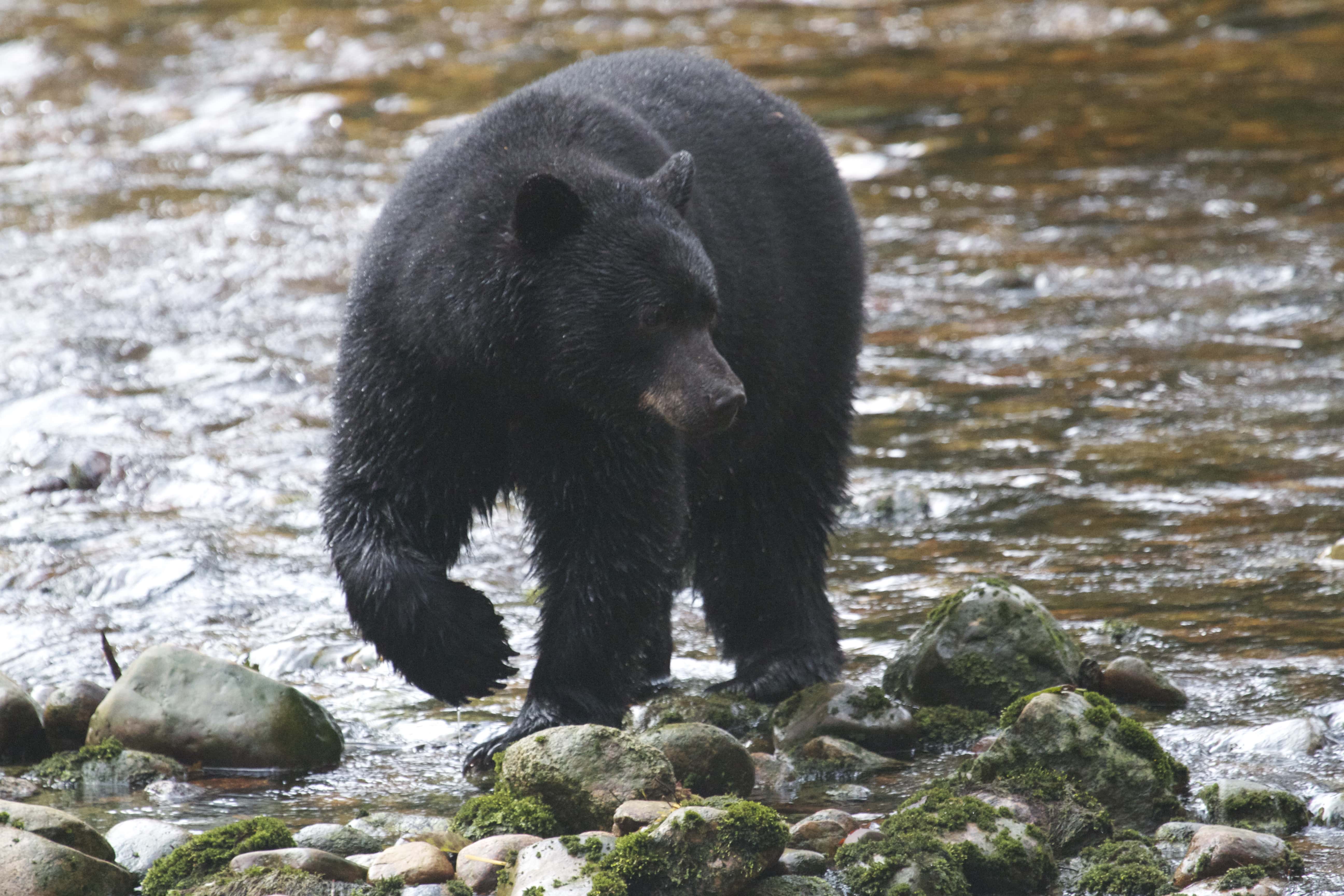
Interested in booking a tour? Join us during your visit to Tofino!
Search
Recent Posts
Categories
The History & Wonder of Hot Springs Cove
LONG BEACH
NATURE JOURNAL
HOME > LONG BEACH NATURE JOURNAL > THE HISTORY AND WONDER OF HOT SPRINGS COVE
The History and Wonder of Hot Springs Cove
A must-see on any travel list while visiting the West Coast of Vancouver Island is a tour to the Geothermal Hot Springs in Maquinna Marine Provincial Park, located in Clayoquot Sound. Accessible by a stunning 30 nautical mile boat ride or a beautiful 20-minute floatplane flight from Tofino, followed by a gentle 1.5km hike through old-growth forests along a well-maintained boardwalk.
The area, previously known as Refuge Cove because boat captains sought refuge in the sheltered harbour from fierce Pacific Ocean storms, is the ancestral home of the Ahousaht & Hesquiaht First Nations. Located on a major geological fault, the ocean is pulled into fractured rock 5km below the surface and then heated to over 100 degrees Celsius. After this process, pressure releases the heated water back up through fissures in the rock, and it mixes with ocean water again to produce a much more enjoyable temperature of around 50 degrees Celsius.

In 1933, pioneer Ivan Clarke established a general store to service stranded mariners seeking shelter from the storms. The Nuu-chah-nulth families, who were already living there, were later joined by their neighbors from the north, the Hesquiaht People, who built a settlement at the head of the cove. Over the next 30 years, Clarke built businesses, a schoolhouse, water towers, and a community at the start of the present-day trail out to the Hot Springs. Clarke eventually donated much of his property to the Province of British Columbia, and the area became part of Maquinna Marine Provincial Park.
Visitors departing for the Hot Springs by boat from Tofino will enjoy a journey through Clayoquot Sound and its unparalleled natural beauty. The hour and a half ride weaves through islands, fjords, and a breathtaking remote coastline dwarfed by the Strathcona Provincial Park Mountains behind it. Depending on the time of year, visitors might even see a vast array of West Coast Wildlife, including humpback whales, killer whales, otters, seals, porpoises, and eagles along the way.
Once moored up at the dock, the hike to the Hot Springs begins. The 1.5km relaxing stroll along boardwalks and stairs hugs the coastline and provides ample opportunities to view the vast Pacific Ocean while surrounded by Old Growth Forests and the greens of the West Coast. Upon arrival at the Hot Springs, visitors are greeted by washrooms and a large changing area. After changing, guests venture down the stairs and enjoy the hot geothermal pools dotted around the area while taking in the unmatched vistas of the Pacific Ocean. Depending on the tides, visitors can sit in the hot pools while simultaneously cooling off as the ocean waves wash over the rocks or, if they're brave enough, dunk themselves underneath one of the hot waterfalls that feed this world-famous wonder of nature.
Get in touch today if you'd like to experience this truly magical place for yourself!
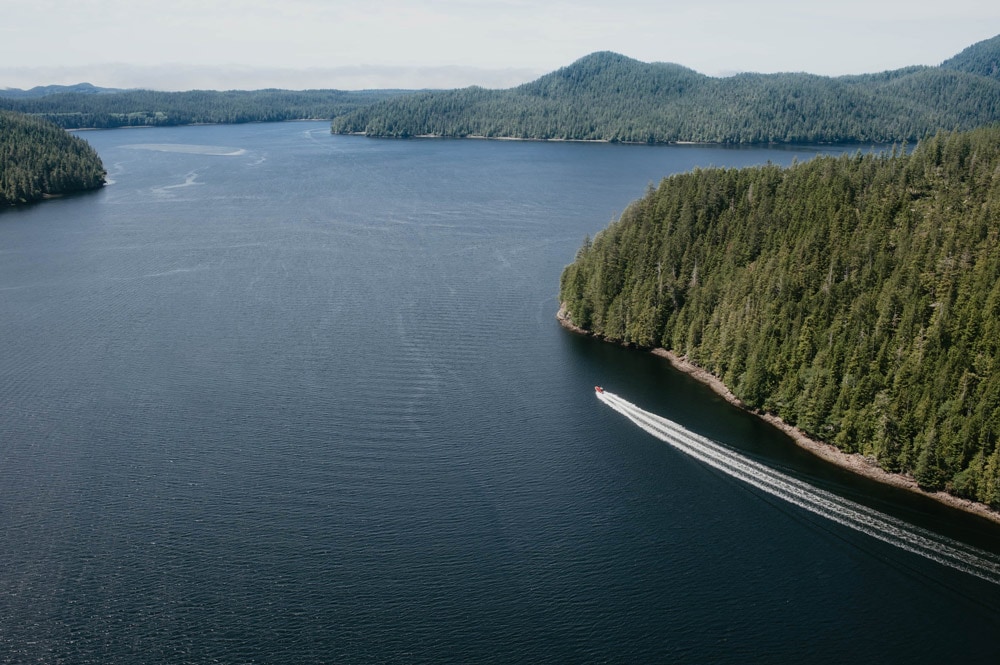
Interested in booking a tour? Join us during your visit to Tofino!
Search
Recent Posts
Categories
Birdwatching in Tofino
LONG BEACH
NATURE JOURNAL
HOME > LONG BEACH NATURE JOURNAL > BIRDWATCHING IN TOFINO
Birdwatching in Tofino
Spring
The lengthening days of spring are a very exciting time for birding the outer coast of Vancouver Island. The mudflats and protected waterways of Clayoquot Sound, a major overwintering site for ducks and other waterbirds, become a stopover site for tens of thousands of shorebirds of 24 species in April and May each year – 40 species of shorebirds have been recorded in the Tofino area. These shorebirds are using our rich mudflats as a short resting and feeding stop as they wing their way north from their wintering grounds that may be as far south as South America. Most of these shorebirds are destined for breeding grounds on the Arctic tundra, many on the north slope of Alaska.
The peak of shorebird migration is the last week in April and the first two weeks in May. Some particularly good spots to watch the shorebirds on the mudflats are at the viewing platform at the end of Sharp Rd in Tofino, and at Grice Bay in Pacific Rim National Park Reserve. Both of these sites are best viewed with a spotting scope at low to medium tides, when mud is exposed for the shorebirds to feed on.
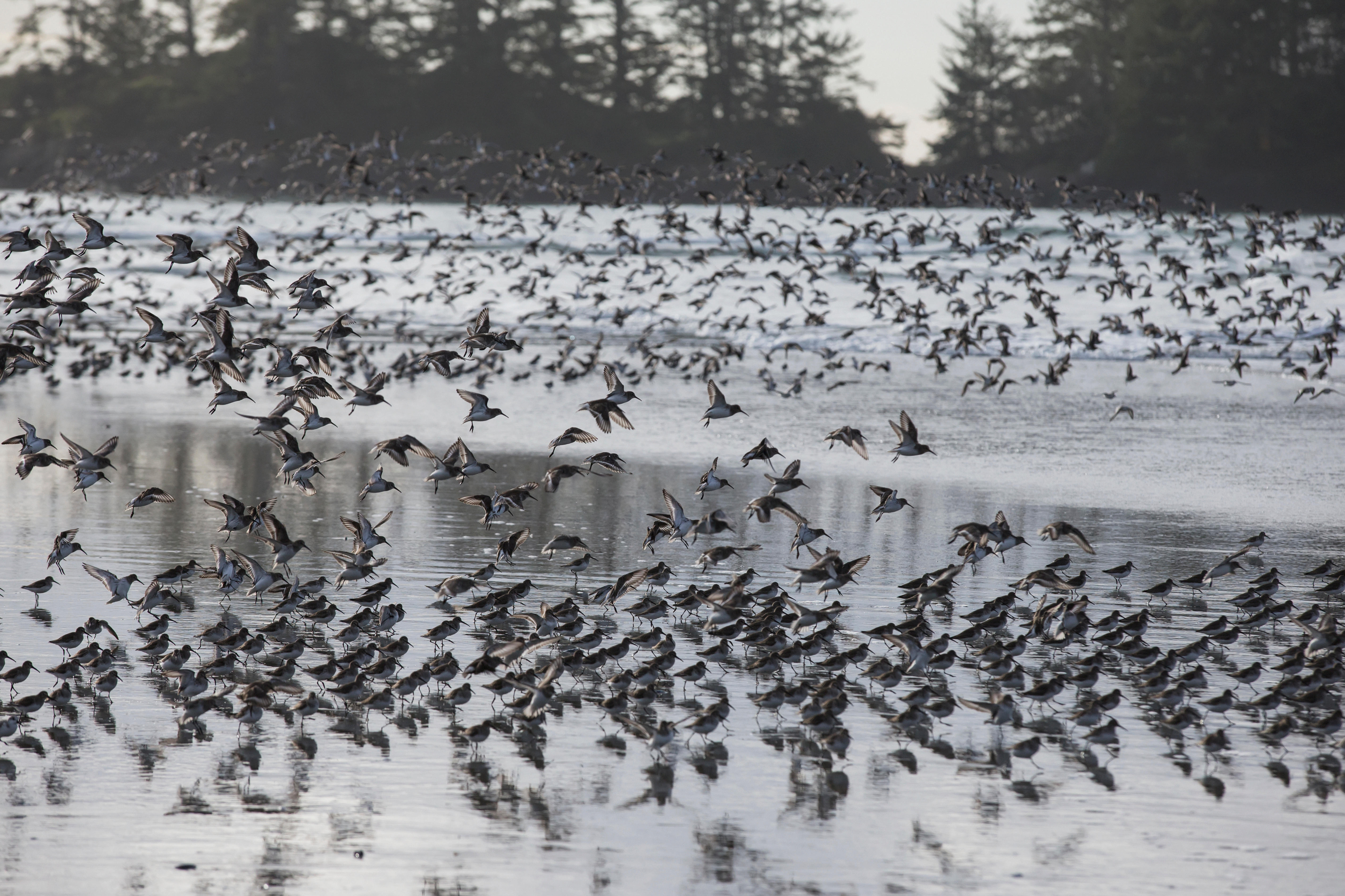
Here in Clayoquot Sound we have the largest numbers of Whimbrel on the BC coast in migration, and up to 100,000 Western Sandpipers have been recorded on the Tofino mudflats in a single day during early May – one of the true spectacles of nature. Rarer species such as Red Knots, a beautiful salmon-pink hue in their breeding plumage, are regularly seen among the large flocks. The sandy beaches of the outer coast harbour another suite of shorebirds, while offshore, Pacific Loons stream north by in the thousands.
On land, colourful songbirds return to our forests from their tropical wintering grounds – it’s a great exercise in birding-by-ear to pick apart all of their songs as they sing from high in the rainforest canopy. With luck, you’ll catch a brilliant flash of yellow as a Townsend’s Warblers or Western Tanager shows itself. And in late April and early May, you’ll see many thousands of Greater White-fronted and Cackling Geese passing northwest overhead – the outer coast is a key migration corridor for them. It’s a spectacle to watch the river of birds heading north.
Summer
The long days of summer are the nesting season for resident birds. Many west coast specialties breed locally and are easy to find all summer – species like Black Oystercatcher, Varied Thrush, Marbled Murrelet, and Hutton’s Vireo. And as soon as the first week of July, fall migration is already on! The beaches and mudflats have arctic-nesting shorebirds stopping over to feed on their southbound journey, first the adults, followed by the juveniles later in summer.
A seawatch with a spotting scope from the Amphitrite Point lighthouse in Ucluelet is one summer favourite – many Marbled Murrelets, Rhinoceros Auklets, Common Murres and Pigeon Guillemots are guaranteed from shore, while the occasional Cassin’s Auklet or Tufted Puffin will fly by. On some days, many thousands of Sooty Shearwaters wheel offshore, a spectacle to watch. And you’ll almost certainly see a sea otter, or a humpback or grey whale. If it’s too foggy to scope offshore, a short drive inland up the Kennedy River will take you out of the fog into the hot sun – and find some of the breeding birds found inland, including Sooty and Ruffed Grouse, Hammond’s Flycatcher, Western Tanager, Black-headed Grosbeak, Black-throated Grey Warbler, and Vaux’s Swift.
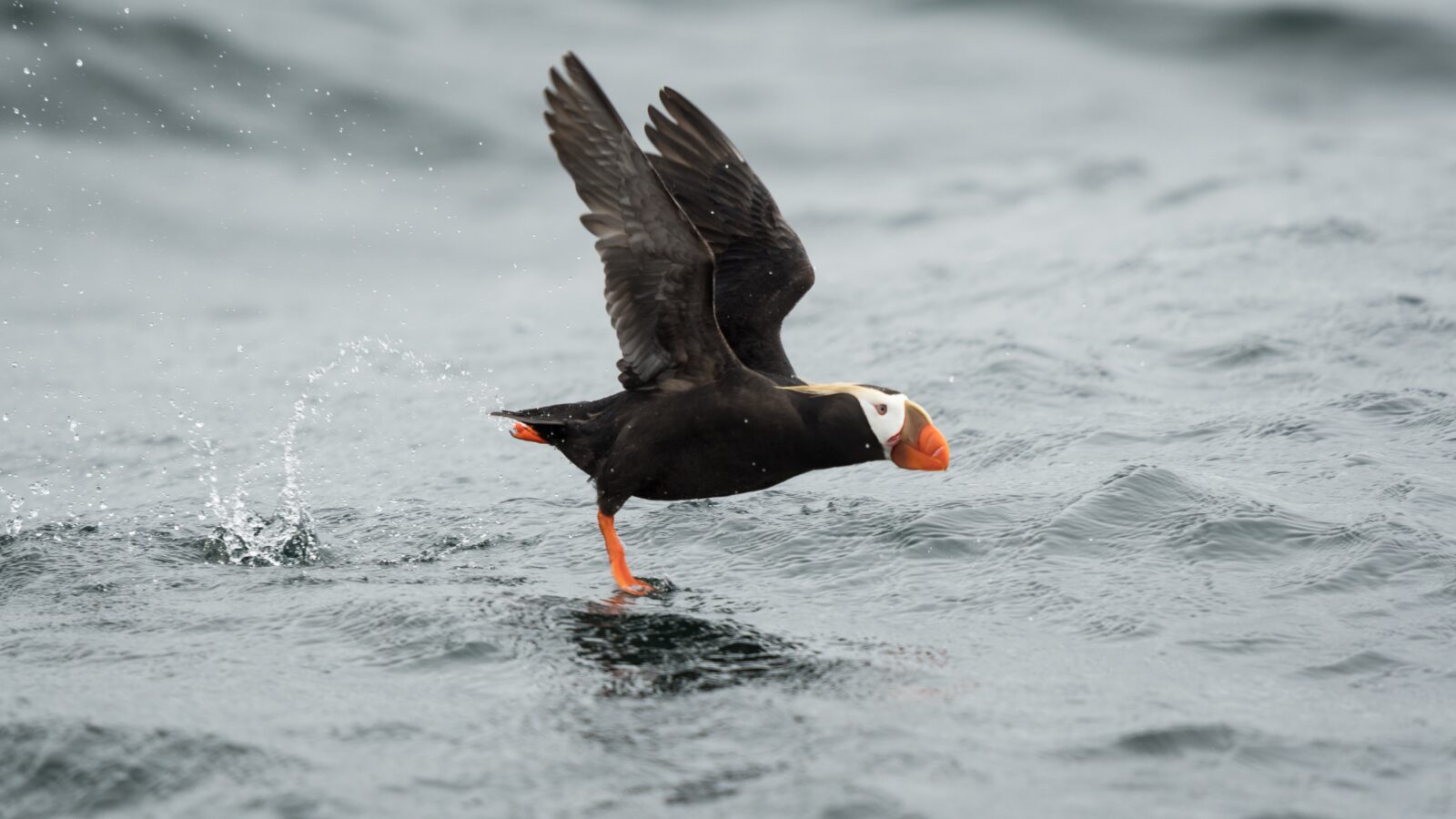
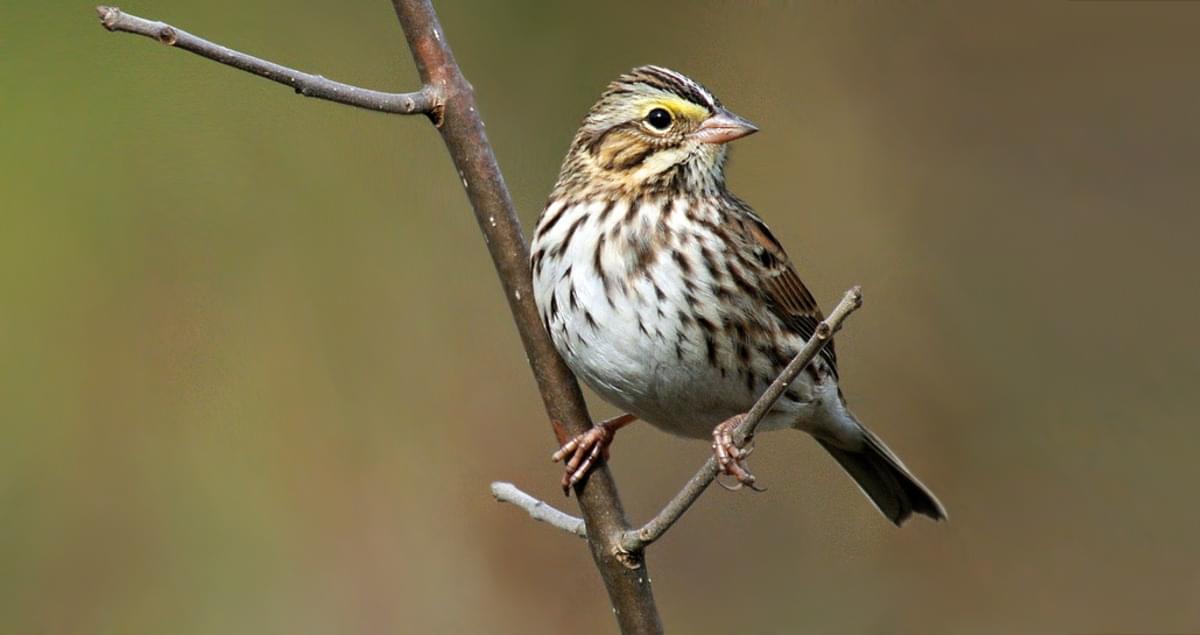
Fall
A season of change and movement, the autumn months provide some of the highest species diversity on the outer coast. From August through October, passerines are flying south in large numbers, with the alder patches harbouring warbler flocks, and the beaches full of Savannah Sparrows. The autumn is the best season for rarities – if you search through enough of these flocks of common species, you’re guaranteed to find some strays, especially here on the outer coast where windblown or off-course birds blow in off the ocean.
I love going for long walks on our outer coast beaches in the autumn – you never know what rare birds you might find. Seawatching provides a steady stream of waterfowl, alcids, and gulls flying by – including the beautiful Heermann’s Gull which comes north to visit our shores from Baja California, from July through November each year. The rocky coastlines will have Wandering Tattler, Black Turnstone and Surfbird from July onwards, while the mudflats are teeming with returning shorebirds, ducks, grebes, loons and geese.
Winter
Birding is a year-round activity here – the wet coast has the highest bird diversity of Canada in the winter months, with over 100 species possible on a winter’s day here. While storms kick up huge waves on the open ocean, the inlets remain protected and calm, sheltering large flocks of waterfowl, and the mudflats have hundreds of Dunlin, Sanderling, and Black-bellied Plovers. Grice Bay and the head of Ucluelet Harbour are fantastic spots to scope these protected waters. You’ll even see species like Trumpeter Swans overwintering on the inlets here. The towns of Tofino and Ucluelet, with their diversity of ornamental shrubs and trees and feeders, turn up rare passerines every winter – a walk around the town streets can easily turn up a rare warbler, or in October and November, even a Tropical Kingbird, among the flocks of common songbirds like Golden-crowned Sparrows and Chestnut-backed Chickadees.
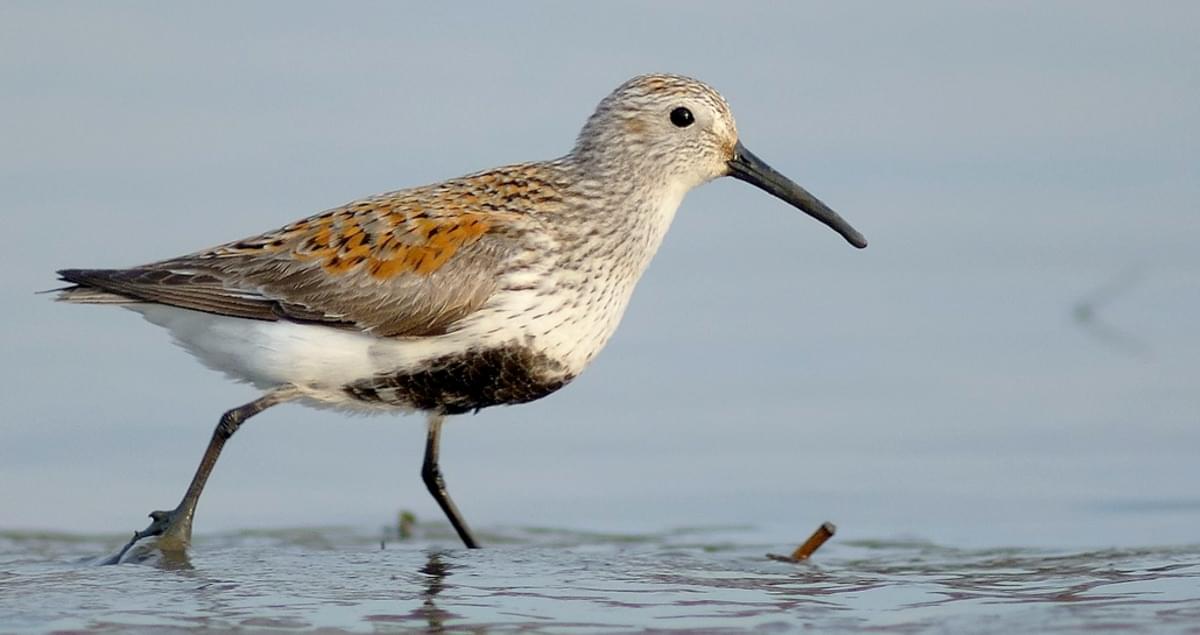
Interested in birding? Join a private tour with our local bird expert Ian during your visit to Tofino!
Search
Recent Posts
Categories
Best Hikes in Tofino & Ucluelet
LONG BEACH NATURE JOURNAL
The Best Hikes in Tofino & Ucluelet
HOME > LONG BEACH NATURE JOURNAL > BEST HIKES IN TOFINO & UCLUELET
Tofino and Ucluelet are one of the most visited regions of Vancouver Island, and many people come here specifically for the outstanding hiking and opportunities to escape into nature. But you don't need to be an experienced hiker to enjoy the trails here. Hikes range from less than a half of a kilometre to multi-day treks, with trails for all ability levels.
If you have time for only a few short hikes or walks, the best hikes in Tofino and Ucluelet are the Nuu-chah-nulth Trail, South Beach Trail, Halfmoon Bay Trail, the Shore Pine Bog Trail, Tonquin Beach Trail or the Wild Pacific Trail.
However, if you want to experience some of Tofino's best signature hikes, see our
Top 2 Best Hikes in Tofino and Ucluelet
#1 THE PACIFIC RIM COAST TRAIL
Pacific Rim National Park Reserve
4-6 hours | 14 km | Moderate
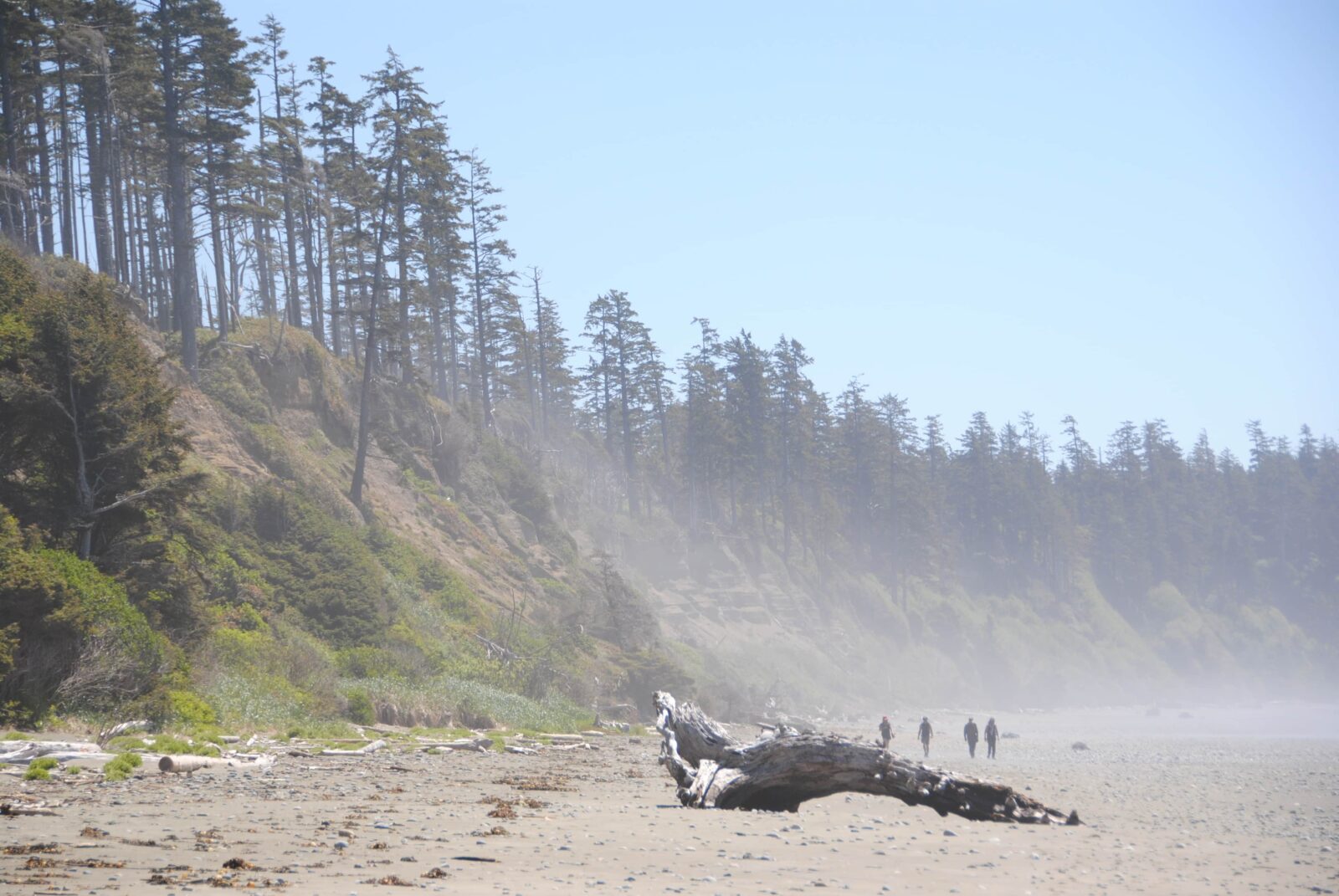
The Pacific Rim Coast Trail in Pacific Rim National Park Long Beach Unit is considered one of the best day hikes in Tofino and Ucluelet; an iconic experience within easy reach of both communities. The 14 kilometre route is comprised of 4 beautiful beaches and 5 of the National Park's trails, a moderate 4-6 hour trip for most hikers.
The scenery along the trail is simply magnificent, with endless views of the Pacific Ocean, sandy beaches, rugged shoreline and temperate rainforests.
Trail Overview
Begin your hike at Willowbrae trailhead at the entrance to Wya Point Resort. The forest is thick with western hemlock, sitka spruce and western red cedars. This route leads down to the secluded, Halfmoon Bay. A great spot to warm up for the hike ahead and stop for your first snack and water break.
Continuing north along the Pacific Rim Coast Trail, you arrive at at what locals refer to as South Flo. Passing sharp cliffs of an ancient glacial moraine hike north across this coastline where you often are able to spot Grey Whales from shore. As you near the northern end of Florencia Bay, travel the Nuu-chah-nulth boardwalk and keep your eyes out to for unique carnivorous plants and twisted shore pines. Continue on to South Beach where we suggest is a great spot to stop for lunch. Here the wild and beautiful coastline is marked by jagged bluffs, a reminder of the ageless struggle between land and sea.
After lunch, you will pass Lismer Beach and reach the expanse of Wickaninnish Bay. Here you can take a break and visit the Kwistis Visitor Centre where you can find public washrooms, refill your water bottle and walk through the exhibit about the land, sea, sky and people of the area. When you ready to jump back to complete the Coast Trail you will continue north across Wickaninnish Beach and dunes until you reach the Combers Beach trail where you will jump back into the forest for the last section of the route.
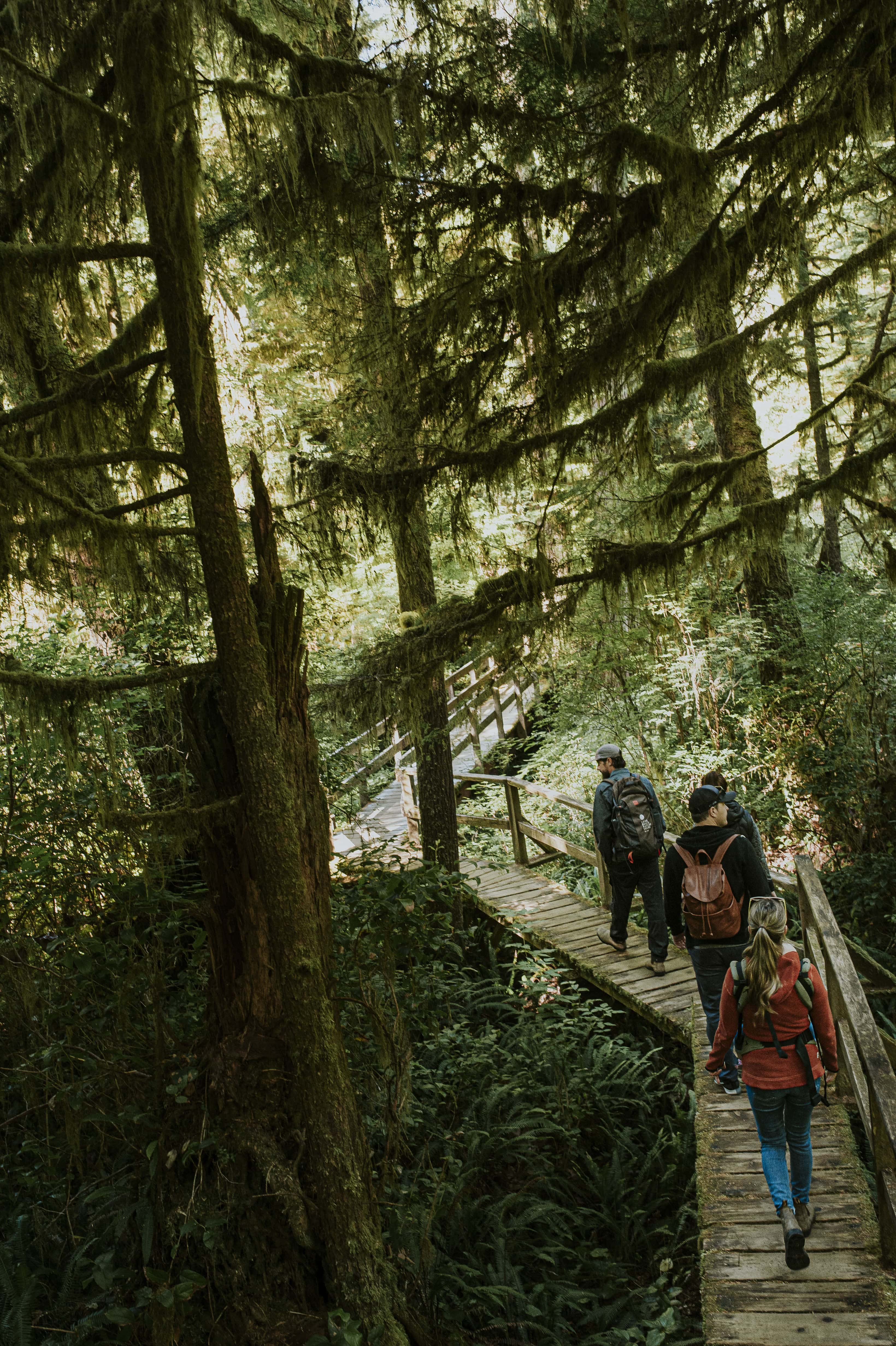
Hiking the entire trail requires transport to return to the starting trailhead. The easiest way to return to the Willowbrae Road starting point at the end of the hike is to leave a second car at the Combers Beach parking area, or arrange to be picked up. Parties with two cars can start from each end and exchange car keys for the return journey home. There is currently no public transportation between the Willowbrae Road and Combers Beach parking areas. It is possible to hike portions of the Pacific Rim Traverse. Hikers setting out from the Willowbrae Trail can exit at the Florencia Bay parking area (5.5 km) or again at the Kwisitis Center parking area (8.5 km) without backtracking along the trail. If you feel like you are up for a challenge and are motivated to push past the 14 km standard route; it is possible to continue all the way to the end of the Schooner Cove Trail making this a complete traverse of 21 km. But in our experience the 14 km is good for us!
Permits & Fees
An entrance fee* of $20 per vehicle, or $10 per individual, is required to enter Pacific Rim National Park.
*The annual Parks Canada Discovery Pass would cover this entrance fee.
When to Hike
Late-May through October is the best time of year to experience this hike. Big ocean swells and swollen creeks block portions of the trail during the winter, making travel difficult. If you hike during the winter season, go with appropriate rain gear and be prepared to cross creeks up to or over your knees. Check the forecast before you hike in winter and spring.
Hike the Pacific Rim Coast Trail with a Guide
The Pacific Rim Coast Trail hike is offered everyday in the National Park by Long Beach Nature Tours. The tour company handles transportation, gear, snacks, lunch, and provides a professional, knowledgeable guide so you can focus 100% on enjoying your adventure. Read more…
#2 THE WILDSIDE TRAIL
Flores Island Provincial Park, Clayoquot Sound
4-6 hours (one way) | 12 km (one way) | Moderate

The Wildside Trail in Flores Island Provincial Park is our favourite hiking trail in Tofino and Ucluelet - a remote and off the beaten path experience within reach of both communities. The 12 kilometre trail is comprised of 8 of Clayoquot Sound's most beautiful beaches, a moderate 4-6 hour trip for most hikers. This hike for the keener can be done in one day as an out and back trip, but we suggest for optimal experience to make this an overnight trip and camp at Cow Bay at the end of the trail; the most stunning beach in the region.
The scenery along the Wildside Trail is epic, with endless views of the Pacific Ocean, sandy beaches, rugged shoreline and temperate rainforests, making it one of the best hiking trails in the area.
The Wildside Trail Overview
Begin your trip at the First Street Dock in Tofino, where you can catch the 10:15am & 4:30pm scheduled water taxi for about $20. The Ahous Hakuum (water taxi) departs from the Lone Cone Office in Tofino & from the Ahous Fuel Stop on Flores Island daily. The boat ride from Tofino to Flores Island is approximately 30-45 minutes, with a lot of beautiful scenery along the way. Once you arrive in the village of Ahousaht on Flores Island, you begin the walk through town (15min) to reach the trailhead at you first beach of the route.
Continuing along the Wildside Trail, your hike will take you from one beautiful beach to the next, crossing over short hiking trails through ancient rainforests between the sandy shores. At the end of each beach, look out for fishing buoys hanging in the trees marking the entrance to the next trail section. These will be your route markers all the way to the end of the trail and back. Keep your eyes out for animal tracks in the sand as you hike, it is often to find many species that use this trails as well including wolves, bears and cougars! Half way across the trail you will come across Kutcous Creek, your first source of fresh water along the trail and a great place to stop for a snack. From here at low tide you can either wade across Kutcous Creek to shave approximately 1 hour off of your hike or if the tide is too high and you can't wade across, you can take the trail up the river to Kutcous Bridge where you will rejoin the trail. As you continue on, each little cove you cross, the scenery just keeps getting better and better.
At the 10km mark, you will be getting really close to the end of the trail as you hike through the last forest section of the route arriving shortly at the sandy Cow Bay in Flores Island Provincial Park. It is an absolute shame if you don't plan your time to at least enjoy a few hours relaxing at this beach before turning around and hiking back to catch the water taxi back from Ahousaht. There is endless beach combing to be had here at Cow Bay, and a great place to set up a hammock for a quick afternoon snooze. If you only have the one day to do this trek, you better hustle back as 22km is a big day of hiking even for experienced hikers. We highly recommend bringing along your camping gear and spending the night here at Cow Bay before taking the trail back to Ahousaht in the morning.



Hiking the entire trail requires water taxi transport drop off in Ahousaht and pick up to return to Tofino. The trail can be done in a 22km day hike out as an out and back, or a 2 day overnight out and back hike only hiking 11 km each day and is the recommended option. Otherwise, you can hire a private water taxi or to drop you off at Cow Bay in the morning and hike the trail as a one way to Ahousaht which can easily be done as a day trip. The easiest way to do this is to book a guided tour which departs Tofino daily; visit Long Beach Nature's day hike here.
Permits & Fees
There is a $15 permit fee $10.00 per night/Camping for accessing the trail that is payable at the trail office in Ahousaht. The water taxi will be $20 per person each way.
When to Hike
Late-May through October is the best time of year to experience this hiking trail. Big ocean swells and swollen creeks block portions of the trail during the winter and is closed during winter months. Check the forecast before you hike.
Hike the Wildside Trail with a Guide
The Wildside Trail hike is offered everyday by Long Beach Nature Tours. The tour company handles private transportation, gear, snacks, lunch, and provides a professional, knowledgeable guide so you can focus 100% on enjoying your adventure. Read more…
Search
Recent Posts
Categories
Improving your Health and Wellness in Tofino
LONG BEACH NATURE JOURNAL
Improving your Health & Wellness
HOME > LONG BEACH NATURE JOURNAL > IMPROVING YOUR HEALTH AND WELLNESS
Did you know that Canada’s first large-scale nature prescription program just launched in British Columbia, empowering health-care practitioners to formally prescribe time outdoors for the physical and mental health of patients?
Amazing right? Even though this is a relatively new concept to North America, the knowledge of time spent in nature and its connection to personal well being has been understood for centuries in other countries around the world.
Best known here is Canada is whats called, Sinrin-yoku or Japanese Forest Bathing, and Tofino is the perfect place for this! We all know how good being in nature can make us feel and the Japanese have known this for centuries. The sounds of the forest, the scent of the trees, the sunlight playing through the leaves, the fresh, clean air — these things give us a sense of comfort. Forest bathing helps to ease our stress and worry, & helps us to relax and to think more clearly. Being in nature can restore our mood, give us back our energy and vitality, refresh and rejuvenate us.
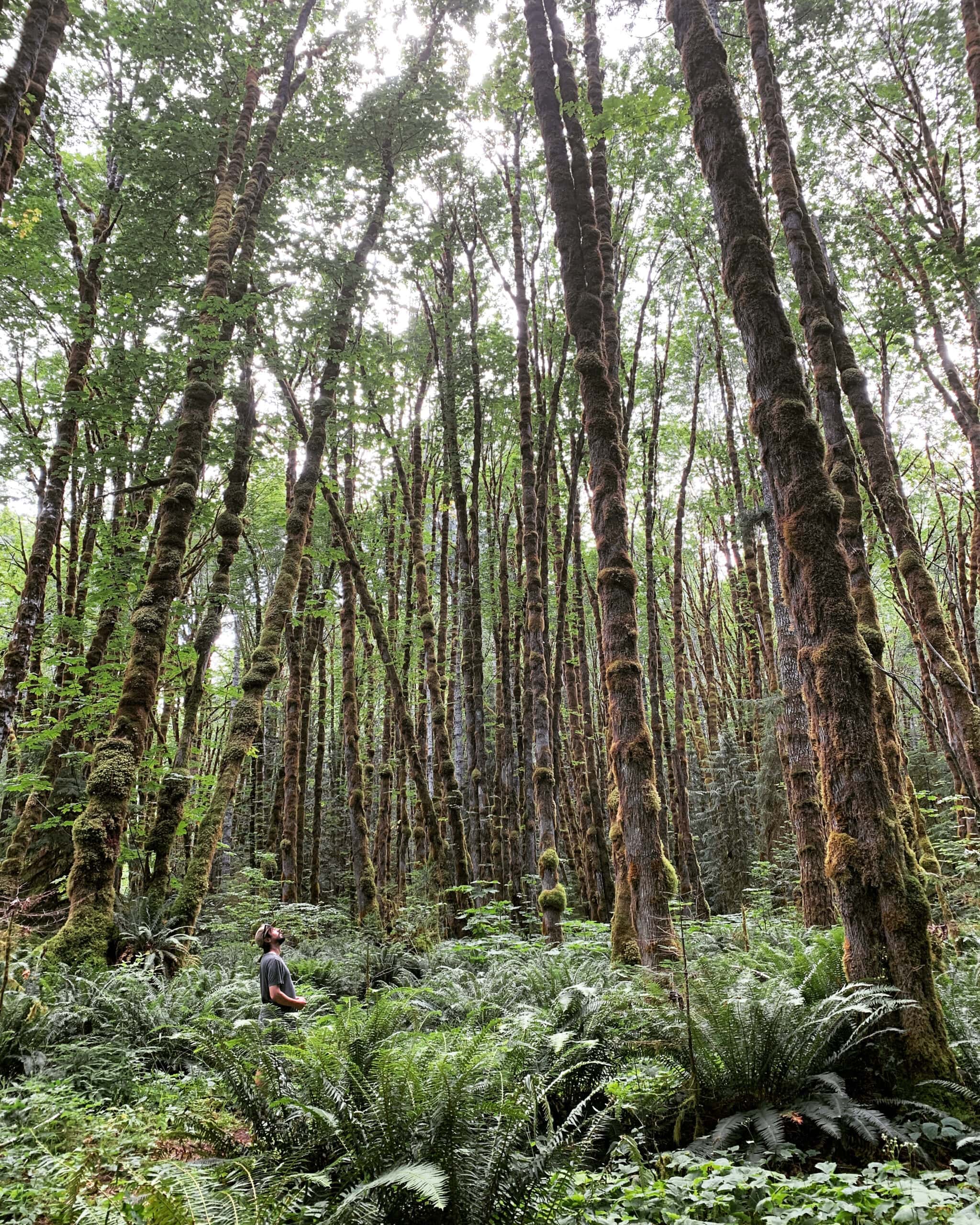
The health benefits of time spent in nature have been the subject of intense study in recent years, and have proven to be broad. The largest meta-analysis of its kind, including data from 143 studies internationally and published in the journal Environmental Research in 2018, concluded that increased green space exposure was associated with decreased cortisol (stress) levels, heart rate, diastolic blood pressure, HDL cholesterol, risk of pre-term birth, Type 2 diabetes and all-cause and cardiovascular mortality, and increased incidence of good self-reported health.
And new studies continue to reinforce past results. For example in Finland, 36 Finnish daycare children were transformed from being primarily gravel-based to primarily nature-based and after 28 days in this wilder setting, the children's skin and gut microbiota became more robust and diverse, while markers of immune health and anti-inflammatory function surged. Getting results like this for health-care practitioners is a major win.
Back here in North America, we all know in our hearts that we have lost that personal connection with nature and that it lives somewhere “out there” beyond our reach of our ever growing concrete jungle. This year in 2020, we have seen huge impacts on our personal well being with the pandemic and the urge for us to escape into nature was seen here this past summer in British Columbia. Provincial and National Parks across the province saw record numbers of users, accessing these environments and spending more time in nature than ever before.
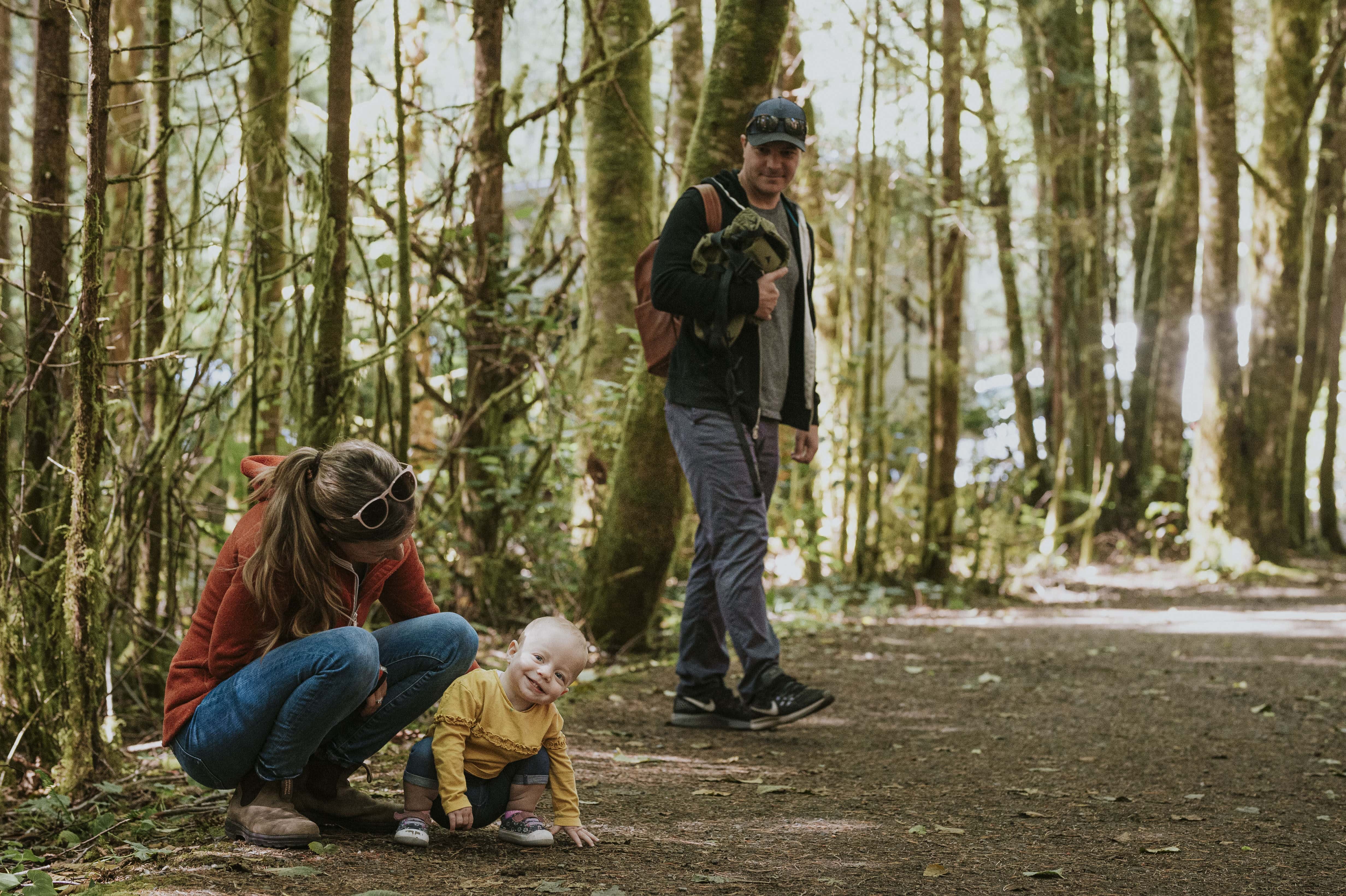
Now with an actual health care plan in place, in the coming months this program is hoping to expand to other provinces and territories, forging partnerships between health-care and parks organizations. Nature is an essential health service and we are very excited to see programs like this be official recognized and become apart of Canada’s health care plan. We encourage all of you to take a few hours every week to disconnect and spend some time in a green space near you. Leave your devices behind, and plug in to the world around you.
More more information and to learn more about nature’s health benefits visit:
Search
Recent Posts
Categories
Top 5 Things to Do in Tofino
LONG BEACH NATURE JOURNAL
Top 5 Things To Do In Tofino
HOME > LONG BEACH NATURE JOURNAL > TOP 5 THINGS TO DO IN TOFINO
Tofino is an extraordinary playground. Whether you're a land lover or ocean lover, the west coast of Vancouver Island has so much to offer with a dizzying array of activities, most of which can be easily accessed by town.
Here are our Top 5 Unique Things to do in Tofino, with something for every level and ability:
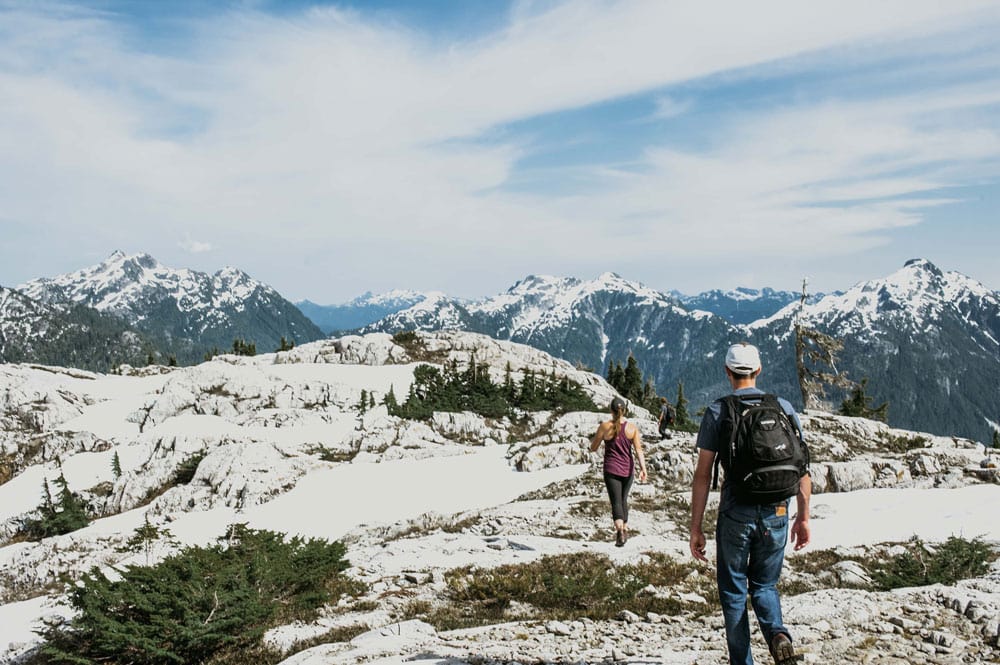
#1 HELI-HIKING
Why go Heli Hiking? That’s a good question with a short answer – Why not? Let’s go one step back and look into the key advantages of using a helicopter. Rather than seeing it as a costly way to get around, think of it as covering long distances in a short amount of time.
A helicopter is able to access remote areas you wouldn’t have a hope of getting to any other way. So especially for time-short travellers, using a helicopter in combination with a hike makes total sense. It actually elevates a tour like this to a whole new level. And who doesn’t enjoy getting away from mainstream tourism – everyone loves that!
Helicopters are widely used in British Columbia. In fact we have some of the best helicopter pilots in the world. Given the nature of British Columbia’s remote and wild locations, helicopters have been essential for research, conservation and tourism. In a matter of a few minutes you can escape into pure nature. No one has the time to go to these remote areas on foot – this would involve weeks of strenuous hiking, bushwacking and scrambling.
What I personally find amazing is the total contrast between our sophisticated ‘coffee and surf culture’ and to the moss-covered classic coastal rainforest and snow-covered alpine peaks. Instead of traffic noise, you’ll get the pure sound bird song of the hermit thrush or the call of a white-tailed Ptarmigan. Two different worlds! Seriously, you have to do it. It’s a life-changing experience that far outweighs any price tag.

#2 BOAT CRUISE THROUGH CLAYOQUOT SOUND
Clayoquot Sound is a primal place, rugged and wild, with crashing surf and exposed coastline out of tranquil and calm of narrow and mountainous fiords. Part of the UNESCO Biosphere Reserve and within the Biosphere we have 16 Provincial Parks and 2 Ecological Reserves. This region has wildlife ranging from Stellar & California sea lions, seals, gray whales, to black bear and coastal wolves. Travel to what feels like the edge of the Earth or literally the end of the road on day, overnight, and multi day adventures through Tofino and Clayoquot Sound.
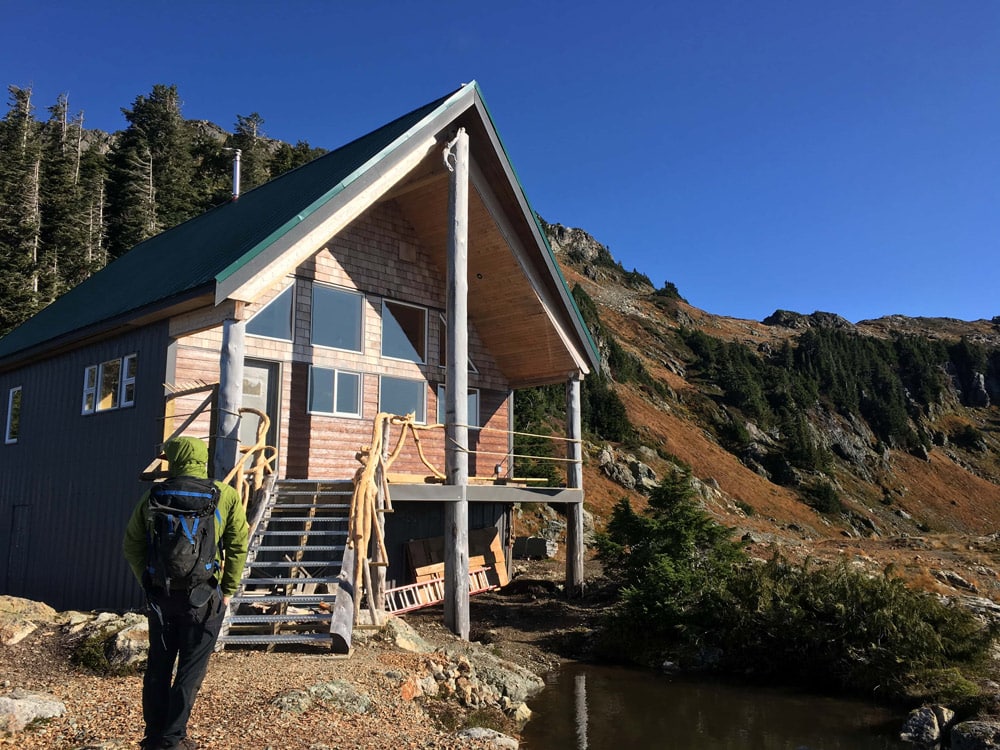
#3 OVERNIGHT IN A BACKCOUNTRY HUT
Most visitors don’t know that Canada has a network of hundreds of backcountry huts scattered throughout the country. The majority located in British Columbia and Alberta, managed by the Alpine Club of Canada, the huts range from popular and well-maintained 20-bunk hideaways to two-bunk rustic cots. If you want to see the best of Tofino’s backcountry, this is the way to do it. Our 5040 hut trip only a short drive from the surf town of Tofino, you can experience this alpine environment from a lunch at the 5040 hut or spend the night and enjoy an epic sunset over the pacific ocean from the comfort of this alpine refuge.
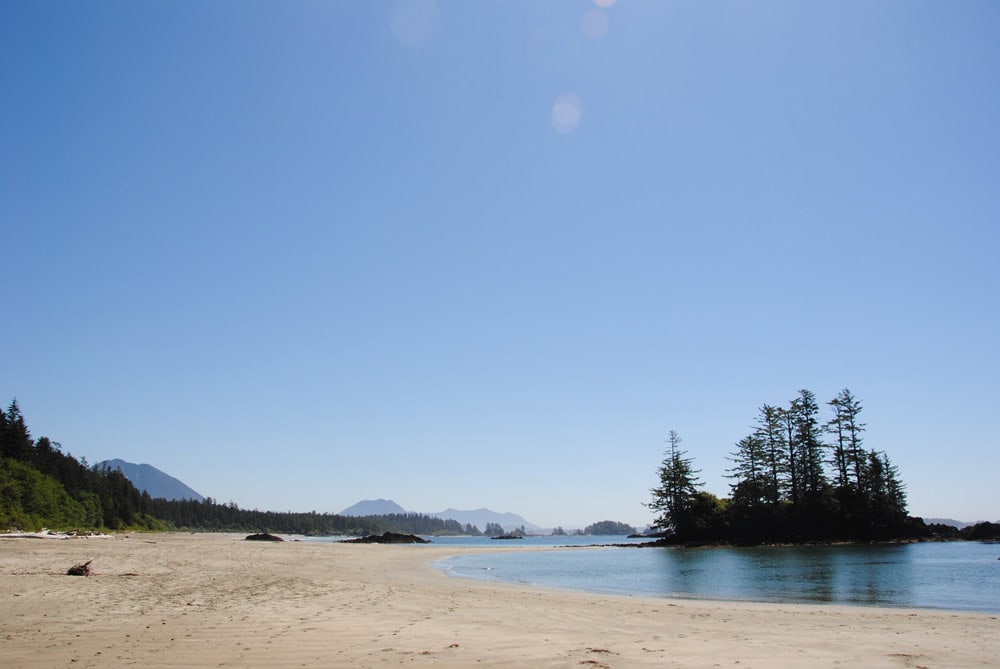
#4 TAKE A GUIDED COASTAL TREK
With all this nature on hand, Tofino has more than its fair share of guides and tour companies. With increasing numbers of people engaging in wilderness activities, pristine and fragile coastal and mountain environments will suffer rising impacts. As a professional user who benefits from these areas, our company and guides will make extra effort to minimize impacts, will set an example for other visitors and instruct our guests how to reduce impact. Our guides are stewards of the environment as a profession and assist local ENGOs with ongoing initiatives. We hope that this will help ensure that our local ecosystem will remain relatively unchanged for the future. Experience the 4 day trek on the Nootka Trail, a remote and difficult region to access, taking a float plane from Tofino makes this a great jumping point to begin planning your adventure to this incredible trek. If you are tight for time, why not try Flores Island for a day hike from Tofino as a great introduction to Clayoquot Sound.
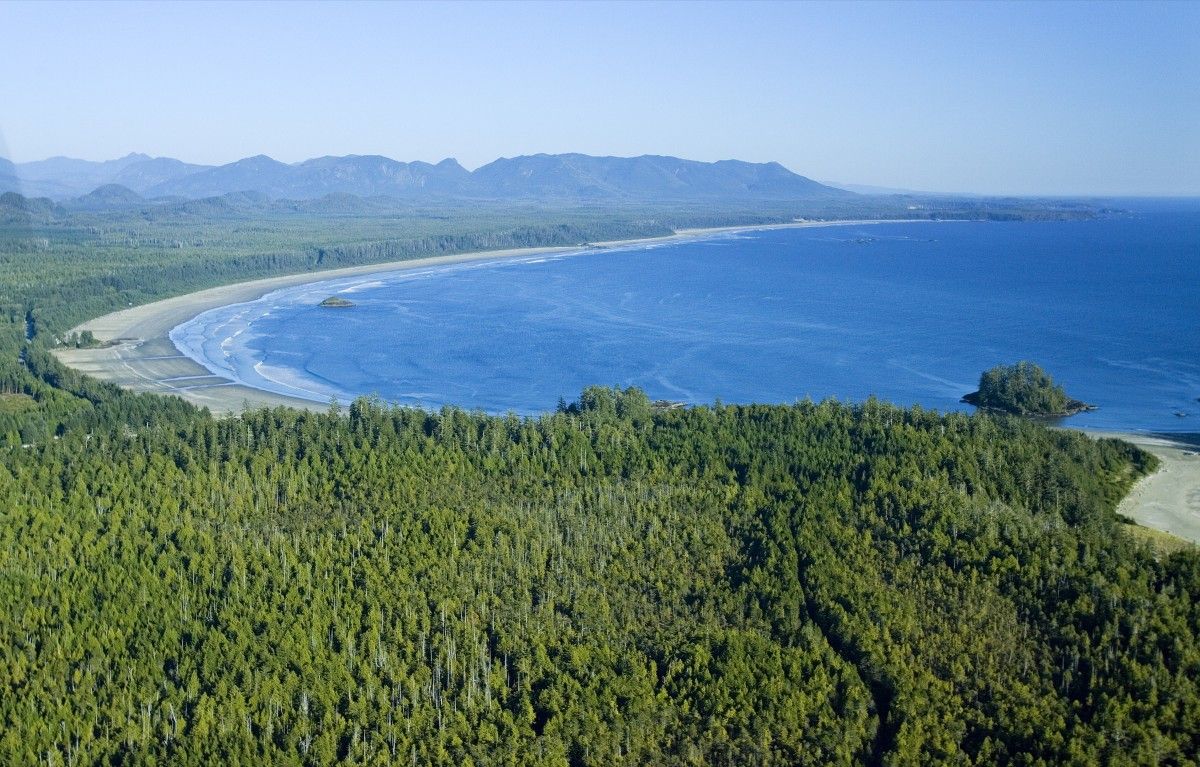
#5 EXPLORE PACIFIC RIM NATIONAL PARK RESERVE
Pacific Rim National Park Reserve is a 511 km² park located in British Columbia, Canada, which comprises three separate regions: Long Beach, the Broken Group Islands, and the West Coast Trail. It represents the Pacific Coast Mountains landscape which is characterized by rugged coasts and temperate rainforests. From Tofino and Ucluelet you have easy access to Long Beach and Broken Group Islands. Long Beach hosts a variety of wonderful trails and boardwalks and can be experienced fully when joining our guided Pacific Rim Traverse hike or if you're not a hiker, maybe try a surf lesson and embrace the Pacific Ocean as Long Beach and Wickaninnish Beach are world renowned for their surf breaks. The National Park is the backbone of our community and can not be missed during a visit to Tofino.
Search
Recent Posts
Categories
Official Trail Guide to Tofino & Ucluelet
LONG BEACH NATURE JOURNAL
Official Trail Guide to Tofino & Ucluelet
HOME > LONG BEACH NATURE JOURNAL > TOFINO AND UCLUELET'S OFFICIAL TRAIL GUIDE
Tofino and Ucluelet are known for their endless beaches and Canada's best year round surfing location but it is also a haven of peaceful rainforest trails with incredible west coast scenery. From short trails & walks to the famous West Coast Trail multi-day trek, the Pacific Rim region has a lot to offer for the hiking enthusiast. Below is our official trail guide to Tofino, Ucluelet and the west coast of Vancouver Island.
Short Walks
NEAR TOFINO & UCLUELET
Day Hikes
NEAR TOFINO & UCLUELET
Trekking
NEAR TOFINO & UCLUELET
Tonquin Trail - Tofino
The Tonquin trail is a wonderful walk close to the town of Tofino and is perfect for anyone looking to get out and stretch their legs during any month of the year. This easy trail is a mix of wooden boardwalks and gravel, with a number of quiet and secluded pocket beaches along the way. Hikers might go as far as Middle Beach before heading back to the starting point at the end of Tonquin Beach Road. Otherwise you have the option to continue on and hike the Tonquin Industrial Connector Trail and enjoy a drink at the Tofino Brewery Co before heading back on the trail. This brings the walk to approximately 7km out and back. (about 2 hrs plus drinks).
3-7 kilometres Easy
Wild Pacific Trail - Ucluelet
The Wild Pacific trail is a breathtaking coastal walk close to the town of Ucluelet. Known for its dramatic and rugged shoreline and epic winter storm watching locations, this trail is perfect for anyone looking to get out and enjoy the outdoors during any month of the year. This easy trail is a well maintained gravel route with a number of quiet secluded coves and many lookout view points along the way. We recommend starting at its northern end; the Ancient Cedars trailhead, where you can explore the Rocky Bluffs and work your way to the Blackrock Oceanfront Resort where we suggest a visit at their spectacular restaurant patio for lunch before heading back on the trail. This brings this walk to approximately 7km out and back. (about 2 hrs plus the restaurant stop.)
Lighthouse Loop Trail - Ucluelet
As part of the larger Wild Pacific trail, the Lighthouse Loop trail features a stop at an active lighthouse, located at the southern point of the Ucluth Peninsula in the town of Ucluelet. Also known for its dramatic shoreline and epic winter storm watching it is also a great location during the months of March and April during the annual Grey Whale migration. If you are planning a visit during the spring, we highly recommend spending some time to explore this trail and count how many whales pass in front of you as it is common to spot many from the trail.
Combers Beach Trail - Pacific Rim National Park
This trail is a short access route to visit Combers Beach. This is relatively a quieter section of Pacific Rim National Park and provides excellent opportunities for birding and also spotting sea lions on neighbouring sea lion rock a short distance off the beach. This is a good trail to have a pair of binoculars handy for wildlife viewing. The trail itself is quite short but we recommend as you arrive on the beach to head to your right (northwest) and walk to Green point and back. This brings the walk to approximately 4km (about 1.5 hrs).
South Beach Trail - Pacific Rim National Park
As one of the most scenic walks in the Park, the South Beach Trail follows along the shoreline and offers stunning views of Wickaninnish Bay and Lismer Beach on route to the warm black sand of South Beach. This is a great place to go during the summer for a warm beach picnic or during the winter to watch some big storms roll in. We suggest to continue on and connect with the Nuu-chah-nulth Trail.
Willowbrae & Halfmoon Bay Trail - Pacific Rim National Park
A short walk that follows a wide gravel route through the forest before descending down a wooden staircase to a beautiful, secluded beach known as South Florencia. To access Halfmoon Bay turn left nearing the end of the Willowbrae Trail and walk the boardwalk down a steep staircase to a quiet pocket Halfmoon beach.
Nuu-Chah-Nulth Trail - Pacific Rim National Park
This trail is the longest boardwalk in the National Park, which winds through the rainforest between Wickaninnish Bay and Florencia Bay. With a few viewpoints along the route this is one of our favourite short walks in the region. It is also great to pair this walk with the South Beach Trail for a longer excursion.
Rainforest Trail - Pacific Rim National Park
The Rainforest trail has 2 boardwalk trails, one on each side of the Pacific Rim Highway listed as Route A and B. This is a beautiful wooden boardwalk loop that visits some magnificent old growth trees and provides a great opportunity for the rejuvenating practice of forest bathing (Shinrin Yoku).
Shorepine Bog Trail - Pacific Rim National Park
This short loop trail consists entirely of boardwalks and has zero elevation gain making this one of the easiest walks in the National Park. Along with it being the easiest walk, it also is considered the most unique as you go through a completely different landscape than the rest of the trails in the area.
*Closed Indefinitely* Schooner Cove Trail - Pacific Rim National Park
This is one of the most scenic rainforest walks in the park, with a beautiful trail winding through a moss covered forest as you descend towards Schooner Cove. To explore further; once arriving at the beach it is best to turn to your right and continue walking around the corner to Schooner Cove where you will find yourself as the only ones on the entire beach. This is one of our favourite and most beautiful secluded pockets of the National Park. The boardwalk trail is approximately 1 km in length but expanding this walk to Portland Point on the northern side of Schooner Cove turn this walk into approximately 8 km round trip.
Big Tree Trail - Meares Island, Clayoquot Sound
Located on Meares Island the Wanachis-Hilth-huu-is Tribal Park a short boat ride across the harbour from Tofino, the Big Tree Trail has some of the largest western red cedars in British Columbia. This island is rich with history and the trail commemorates these stories and turbulent times. The main trail is a wooden boardwalk that winds it's way through pristine coastal rainforest approximately 1 km in length. If you feel inclined you can push past this boardwalk and continue to walk the entire Big Tree loop but this path is unmaintained and very muddy. The Tribal Park guardians are working hard to extended this trail over the coming years.
Pacific Rim Coast Trail - Pacific Rim National Park
The Pacific Rim Coast Trail in Pacific Rim National Park Long Beach Unit is considered one of the premier day hikes in Tofino and Ucluelet, an iconic experience within easy reach of both communities. The 14 kilometre route is comprised of 4 beautiful beaches and 5 of the National Park's trails including the Willowbrae, Halfmoon Bay, Nuu-chah-nulth, South Beach and Combers Beach trails, a moderate 4-6 hour trip for most hikers.
Wildside Trail - Flores Island, Clayoquot Sound
The breathtakingly beautiful Flores Island Provincial Park is the gateway to the Wildside Trail on Flores Island. The trail winds its way through old growth rainforests and visits 8 of the most spectacular beaches in Clayoquot Sound. Two days are recommended for ultimate trail experience with a stunning campsite at Cow Bay but a round trip day hike is approximately 8.5 hrs covering 22km.
5040 Peak via Cobalt Lake Trail - Marion Valley, Sutton Pass
The Cobalt Lake Trail and 5040 Peak is one of the best alpine day hikes near Tofino & Ucluelet. This out and back trail is approximately 7km round trip and 900m in elevation gain. It is rated as difficult but within the first 1.5hr of the hike you will reach the subalpine with 360 degree views of neighbouring peaks of Sutton Pass. With endless alpine to explore, you could easily spend 2 or 3 nights at the newly built Alpine Club of Canada 5040 Hut. This will allow you to have a lighter pack and a comfortable sleep in this luxurious and fully equipment alpine refuge. This trail can be easily done as a day hike from Tofino and Ucluelet or for optimal experience, spend a night or 2 at the hut and explore the Ridgeline to the north across to Beverly Lake and Nahmint mountain.
*Note: The trailhead is accessed by the Marion Valley logging road. A 4x4 vehicle is required.
Lone Cone - Meares Island, Clayoquot Sound
Located on Meares Island and visible across the harbour from Tofino, the towering mountain known as Lone Cone rises from the ocean. This hike leads you through a steep rainforest trail to a lookout at the top of the mountain which has one epic view over looking the town of Tofino, surround islands and the expanse of the Pacific Ocean. This is an extremely difficult hiking trail and is not recommended for the faint of heart but if you can make it to the top, the views are extremely rewarding. Also we recommend to hike this trail on a clear day, if the mountain is obscured by clouds, you will not see the view!
West Coast Trail - Pacific Rim National Park
The West Coast Trail (WCT) is an iconic backcountry, multi-day backpacking trail that is a bucket list challenge for many hikers. This 75-kilometre (47-mile) thru hike is part of the ancient paths and paddling routes used for trade and travel by first nations and can be accessed from either the southern trailhead in Port Renfrew or the northern trailhead from Bamfield. Ucluelet is an easy gateway to begin your trek, with lots of amenities close by you can prepare for this adventure before taking the water taxi across the sound to begin the trail.
Nootka Trail - Nootka Island, Nootka Sound
The Nootka Trail is becoming known as one of the best coastal treks in British Columbia. This 37 kilometre route primarily consists of a shoreline trail with smaller sections in the forest. Lots of incredible views, varied scenery, abundant wildlife and few people makes this coastal trek rival the more popularly known West Coast Trail. Due to is remoteness and challenging logistics, it helps keep the annual number of hikers down to a few keen adventurers. There are a few main ways you can access this trail but we highly recommend Tofino as a great jumping point to start from with lots of amenities and comfortable lodging makes for a perfect pre and post trek vacation spot. An easy float plane up the west coast to Nootka Island is just as easy as the float plane ride from the other option further north of Gold River.

